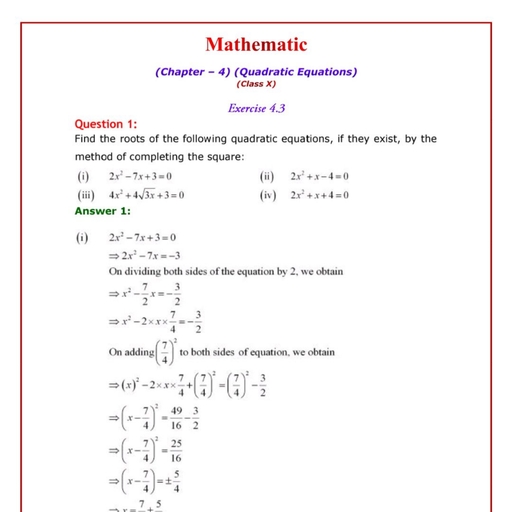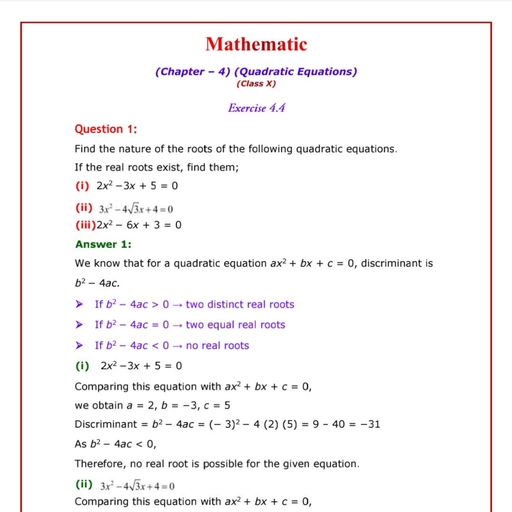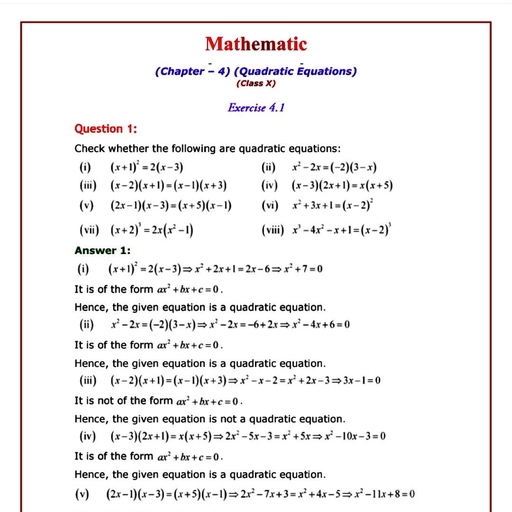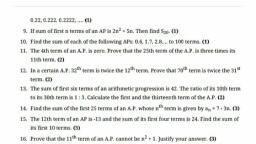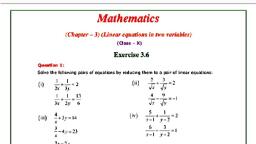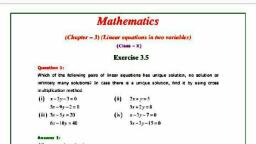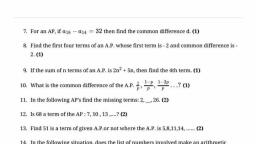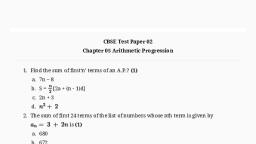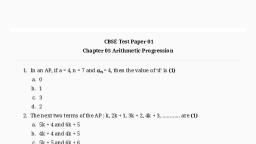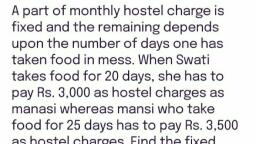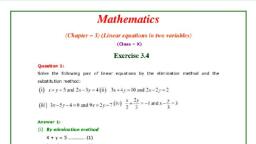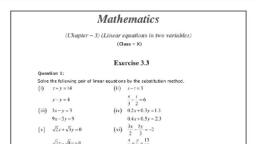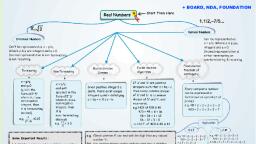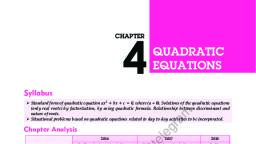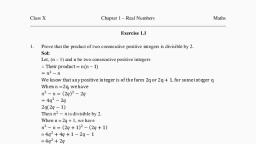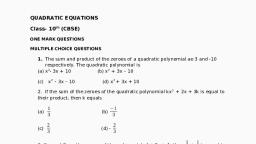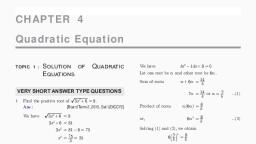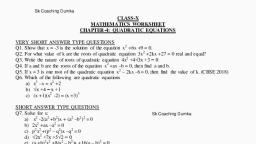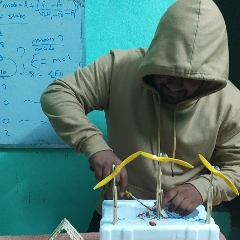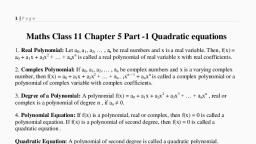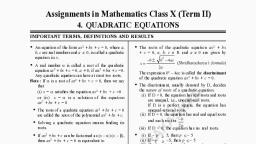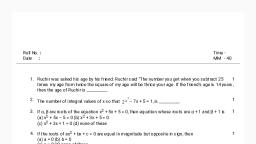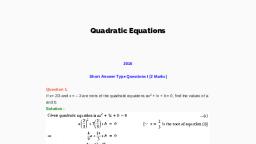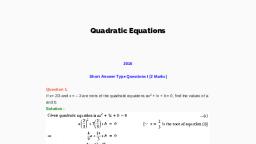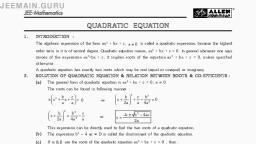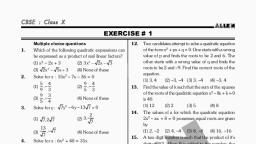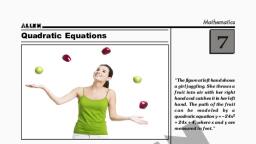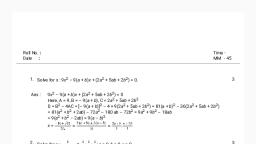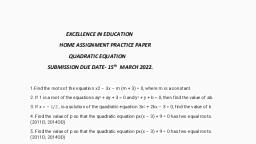Page 1 :
8. Quadratic Equations, Exercise 8.1, 1. Question, Which of the following are quadratic equations?, (i), (ii), (iii), (iv), (v), (vi), (vii), (viii), (ix), (x), (xi), (xii), (xiii), (xiv), (xv), Answer, A polynomial equation is a quadratic equation, if it is of the form ax2 + bx + c = 0 such that a ≠ 0, (i), It is a quadratic equation., (ii), It is a quadratic equation., (iii), ⇒ x4 -5x2 + 1 = 0
Page 2 :
It is not a quadratic equation as the highest power of x is ‘4’., (iv), ⇒ x2 – 3 = x3, It is not a quadratic equation., (v), It is not a quadratic equation as √x is present instead of ‘x’., (vi), It is not a quadratic equation as an additional √x term is present., (vii), ⇒ 2x2 + 2x + 6 = 0, It is a quadratic equation., (viii), ⇒ x2 + 1 – x = 0, It is a quadratic equation., (ix), It is a quadratic equation., (x), , ⇒ x4 + 1 + 2x2 = 3x3 + 3x + 4x2, It is not a quadratic equation., (xi), ⇒ 6x2 + 7x + 2 = 6x2 – 18x + 12, ⇒ 25x = 10, It is not a quadratic equation., (xii), ⇒ x2 + 1 = x3, It is not a quadratic equation., (xiii), ⇒ 16x2 – 3 = 10x2 + 19x – 15, ⇒ 6x2 – 19x + 12 = 0, It is a quadratic equation.
Page 3 :
(xiv), ⇒ x3 + 8 + 6x2 + 12x = x3 – 4, ⇒ 6x2 + 12x + 12 = 0, It is a quadratic equation., (xv), ⇒ x2 + x + 8 = x2 – 4, ⇒ x = - 12, It is not a quadratic equation., 2. Question, In each of the following, determine whether the given values are solutions of the given equation or not:, (i), (ii), (iii), (iv), (v), (vi), (vii), Answer, We will have to check for each value and see whether it satisfies the equation., (i), For x = 2,, 22 – 3 × 2 + 2 = 0, ⇒0=0, Thus, x = 2 is a solution., For, x = 1, 12 – 3 × 1 + 2 = 0, ⇒0=0, Thus, x = 1 is a solution., (ii), For x = 0,, ⇒0+0+1=0, ⇒ 1 = 0 which is not true thus x = 0 is not a solution, For x = 1,, ⇒1+1+1=0
Page 4 :
⇒ 3 = 0 which is not true thus x = 1 is not a solution, (iii), For x= √3, ⇒ 3 – 3√3 × √3 + 6 = 0, ⇒3–9+6=0, ⇒0=0, Thus, x = √3 is a solution, For x = -2√3, ⇒ (-2√3)2 – 3√3 × -2√3 + 6 = 0, ⇒ 4 × 3 + 18 + 6 = 0, ⇒ 36 = 0 which is not true, thus x = -2√3 is not a solution, (iv), For x = 5/6, , ⇒ 61 = 65 which is not true, thus x = 5/6 is not a solution, For x = 4/3, , ⇒ 25/12 = 13/6, ⇒ 25 = 26 which is not true, thus x = 4/3 is not a solution, (v), For x = 2,, ⇒2×4–2+9=4+4×2+3, ⇒ 15 = 15, thus x = 2 is a solution., For x = 3, ⇒2×9–3+9=9+4×3+3, ⇒ 24 = 24, thus x = 3 is also a solution, (vi), For x = -√2,, ⇒ 2 - √2 × -√2 – 4 = 0, ⇒2+2–4=0, ⇒0=0, Thus, x = -√2 is a solution
Page 5 :
For x = -2√2, ⇒ 4 × 2 - √2 × -2√2 – 4 = 0, ⇒8+8–4=0, ⇒ 12 = 0 which is not true, thus x = -2√2 is not a solution, (vii), For, x = a/b, , ⇒ a4/b2 – 3a2 + 2b2 = 0 which is not true, thus x = a/b is not a solution, For x = b/a, , ⇒ b2 – 3b2 + 2b2 = 0, ⇒ 0 = 0 , thus x = b/a is a solution, 3. Question, In each of the following, find the value of k for which the given value is a solution of the given equation:, (i), (ii), (iii), (iv), Answer, For the given value to be a solution, it should satisfy the quadratic equation, (i), ⇒ 7 × 4/9 + k × 2/3 – 3 = 0, ⇒ 2k/3 = 3 – 28/9 = - 1/9, ⇒ k = -1/6, (ii), ⇒ a2 – a(a + b) + k = 0, ⇒ a2 –a2 – ab + k = 0, ⇒ k = ab, (iii), ⇒ k × 2 + √2 × √2 – 4 = 0, ⇒ 2k = 2, ⇒k=1, (iv)
Page 6 :
⇒ a2 – 3a × a + k = 0, ⇒ k = 2a2, 4. Question, If, , are the roots of the equation, , , find the values of a and b., , Answer, Given: If, , are the roots of the equation, , To find: the values of a and b., Solution: Quadratic equation in roots form:, (x – a)(x – b) = 0, where a and b are the roots, Given,, , are the roots of the equation, , Quadratic equation is,, (x – 2/3)(x + 3) = 0, ⇒ x2 -2x/3 + 3x – 2 = 0, , ⇒ 3x2 +7x – 6 = 0, On comparing with, We get, a = 3 and b = -6, 5. Question, Determine, if 3 is a root of the equation given below:, , Answer, For the given value to be a root, it should satisfy given equation, , ⇒ 0 + 0 = √10, Thus x = 3 does not satisfy the given equation and it is not a root of the equation., , Exercise 8.2, 1. Question, The product of two consecutive positive integers is 306. Form the quadratic equation to find the integers, if x denoted, the smaller integer., Answer, Let the consecutive numbers be ‘a’ and ‘a + 1’ respectively., Given, product of two consecutive positive integers is 306, a × (a + 1) = 306
Page 7 :
⇒ a2 + a – 306 = 0, 2. Question, John and Jivanti together have 45 marbles. Both of them lost 5 marbles each, and the product of the number of marbles, they now have is 128. Form the quadratic equation to find how many marbles they had to start with, if john had x, marbles., Answer, Number of marbles John has is x., Given, John and Jivanti together have 45 marbles., Number of marbles which Jivanti has = 45 – x, Now, both of them lost 5 marbles each, and the product of the number of marbles they now have is 128., So John will have x - 5 marbles and Jivanti will have 45 - x - 5 = 40 - x marbles., ⇒ (x – 5)(40 – x) = 128, ⇒ 40x – 200 + 5x – x2 = 128, ⇒40x – 200 + 5x – x2 - 128 = 0, ⇒45x – 328 – x2 = 0, ⇒ x2 – 45x + 328 = 0, 3. Question, A cottage industry produces a certain number of toys in a day. The cost of production of each toy (in rupees) was found, to be 55 minus the number of articles produced in a day. On a particular day, the total cost of production was Rs.750. If, x denotes the number of toys produced that day, form the quadratic equation to find x., Answer, Number of toys produced that day is ‘x’., Cost of production of each toy (in rupees) was found to be 55 minus the number of articles produced in a day., ∴ Cost of production of each toy = 55 – x, Given, total cost of production = Rs. 750, ⇒ x × (55 – x) = 750, ⇒ -x2 + 55x – 750 = 0, ⇒ x2 – 55x + 750 = 0, 4. Question, The height of a right TRIANGLE IS 7 CM LESS THAN ITS BASE. If the hypotenuse is 13 cm, form the quadratic equation, to find the base of the triangle., Answer, By Pythagoras theorem :, Hypotenuse2 = perpendicular2 + base2, Given, height of a right TRIANGLE IS 7 CM LESS THAN ITS BASE and the hypotenuse is 13 cm., Let the base be ‘x’, ⇒ 132 = (x – 7)2 + x2
Page 8 :
⇒ 169 = x2 – 14x + 49 + x2, ⇒ x2 – 7x – 60 = 0, 5. Question, An express train takes 1 hour less than a passenger train to travel 132 km between Mysore and Bangalore. If the, average speed of the express train is 11 km/hr more than that of the passenger train, form the quadratic equation to, find the average speed of express train., Answer, Given: An express train takes 1 hour less than a passenger train to travel 132 km between Mysore and Bangalore. If, the average speed of the express train is 11 km/hr more than that of the passenger train., To find: the quadratic equation to find the average speed of express train., Solution: Let the average speed of passenger train be ‘x’ km/hr and the time taken by passenger train be ‘t’ hr., Since an express train takes 1 hour less than a passenger train and the average speed of the express train is 11 km/hr, more than that of the passenger train., So, For the express train average speed = x + 11, time taken = t - 1, Since,Distance = speed × time, Given, total distance traveled = 132 kmFor passenger train:, ⇒ x × t = 132, ⇒ t = 132/x, , ...... (1), , Also for express train (x + 11) × (t - 1) = 132, Substitute the value of t from (1),, , ⇒ (x + 11)(132-x) = 132x, ⇒ 132x - x2 +1452 -11x = 132x, ⇒ - x2 -11x +1452 = 0, ⇒ x2 + 11x – 1452 = 0Required quadratic equation, 6. Question, A train travels 360 km at a uniform speed. If the speed had been 5 km/hr more, it would have taken 4 hour less for the, same journey. Form the quadratic equation to find the speed of the train., Answer, Let the speed of the train be ‘a’ km/hr and the actual time taken be ‘t’, Given, train travels 360 km at a uniform speed. If the speed had been 5 km/hr more, it would have taken 4 hour less for, the same journey., Distance = speed × time, ⇒ 360 = a × t, ⇒ t = 360/a, Also, 360 = (a + 5)(t – 4)
Page 9 :
⇒ 360a = (a + 5)(360 – 4a), ⇒ 360a = 360a + 1800 – 4a2 – 20a, ⇒ a2 + 5a – 450 = 0, Upon solving we will get a to be 18.86 and -23.86 but the speed can't be negative so the speed of the train is 18.86, km/hr., , Exercise 8.3, 1. Question, Solve the following quadratic equations by factorization:, , Answer, is already factorized, ⇒ x = 4, -2, 2. Question, Solve the following quadratic equations by factorization:, , Answer, is already factorized, ⇒ x = -3/2, 7/3, 3. Question, Solve the following quadratic equations by factorization:, , Answer, In factorization, we write the middle term of the quadratic equation either as a sum of two numbers or difference of two, numbers such that the equation can be factorized., , ⇒ x2 –x -√3x + √3 = 0, ⇒ x(x – 1) - √3(x – 1) = 0, ⇒ (x - √3)(x – 1) = 0, ⇒ x = √3, 1, 4. Question, Solve the following quadratic equations by factorization:, , Answer
Page 10 :
In factorization, we write the middle term of the quadratic equation either as a sum of two numbers or difference of two, numbers such that the equation can be factorized., , ⇒ 9x2 – 6x + 3x – 2 = 0, ⇒ 3x(3x – 2) + (3x – 2) = 0, ⇒ (3x + 1)(3x – 2) = 0, ⇒ x = -1/3, 2/3, 5. Question, Solve the following quadratic equations by factorization:, , Answer, In factorization, we write the middle term of the quadratic equation either as a sum of two numbers or difference of two, numbers such that the equation can be factorized., , ⇒ 3√5x2 + 30x – 5x – 10√5 = 0, ⇒ 3√5x(x + 2√5) – 5(x + 2√5) = 0, ⇒ (x + 2√5)(3√5x – 5) = 0, ⇒ x = -2√5, √5/3, 6. Question, Solve the following quadratic equations by factorization:, , Answer, In factorization, we write the middle term of the quadratic equation either as a sum of two numbers or difference of two, numbers such that the equation can be factorized., , ⇒ 6x2 + 9x + 2x + 3 = 0, ⇒ 3x(2x + 3) + (2x + 3) = 0, ⇒ (3x + 1)(2x + 3) = 0, ⇒ x = -1/3, - 3/2, 7. Question, Solve the following quadratic equations by factorization:, , Answer, In factorization, we write the middle term of the quadratic equation either as a sum of two numbers or difference of two, numbers such that the equation can be factorized., , ⇒ 5x2 – 5x + 2x – 2 = 0
Page 11 :
⇒ 5x(x – 1) + 2(x – 1) = 0, ⇒ (5x + 2)(x – 1) = 0, ⇒ x = -2/5, 1, 8. Question, Solve the following quadratic equations by factorization:, , Answer, In factorization, we write the middle term of the quadratic equation either as a sum of two numbers or difference of two, numbers such that the equation can be factorized., , ⇒ 48x2 – 16x + 3x – 1 = 0, ⇒ 16x(3x – 1) + (3x – 1) = 0, ⇒ (16x + 1)(3x – 1) = 0, ⇒ x = -1/16, 1/3, 9. Question, Solve the following quadratic equations by factorization:, , Answer, In factorization, we write the middle term of the quadratic equation either as a sum of two numbers or difference of two, numbers such that the equation can be factorized., , ⇒ 3x2 + 11x + 10 = 0, ⇒ 3x2 + 6x + 5x + 10 = 0, ⇒ 3x(x + 2) + 5(x + 2) = 0, ⇒ (3x + 5)(x + 2) = 0, ⇒ x = -5/3, - 2, 10. Question, Solve the following quadratic equations by factorization:, , Answer, In factorization, we write the middle term of the quadratic equation either as a sum of two numbers or difference of two, numbers such that the equation can be factorized., , ⇒ 25x2 + 25x + 4 = 0, ⇒ 25x2 + 20x + 5x + 4 = 0, ⇒ 5x(5x + 4) + (5x + 4) = 0
Page 12 :
⇒ (5x + 1)(5x + 4) = 0, ⇒ x = -1/5, -4/5, 11. Question, Solve the following quadratic equations by factorization:, , Answer, In factorization, we write the middle term of the quadratic equation either as a sum of two numbers or difference of two, numbers such that the equation can be factorized., , ⇒ 16x2 – 27x – 10 = 0, ⇒ 16x2 – 32x + 5x – 10 = 0, ⇒ 16x(x – 2) + 5(x – 2) = 0, ⇒ (16x + 5)(x – 2) = 0, ⇒ x = -5/16, 2, 12. Question, Solve the following quadratic equations by factorization:, , Answer, In factorization, we write the middle term of the quadratic equation either as a sum of two numbers or difference of two, numbers such that the equation can be factorized., , ⇒ √3x2 – 3√2x + √2x – 2√3 = 0, ⇒ √3x2 – √3×√3×√2x + √2x – 2×√3×√3 = 0⇒ √3x2 – √3×√6x + √2x – √6×√3 = 0, ⇒ √3x(x - √6) + √2(x - √6) = 0, ⇒ (√3x + √2)(x - √6) = 0, ⇒ x = √6, -√(2/3), 13. Question, Solve the following quadratic equations by factorization:, , Answer, In factorization, we write the middle term of the quadratic equation either as a sum of two numbers or difference of two, numbers such that the equation can be factorized., , ⇒ 4√3x2 + 8x – 3x – 2√3 = 0, ⇒ 4x(√3x + 2) – √3(√3x + 2) = 0
Page 13 :
⇒ (4x - √3)(√3x + 2) = 0, ⇒ x = √3/4, - 2/√3, 14. Question, Solve the following quadratic equations by factorization:, , Answer, In factorization, we write the middle term of the quadratic equation either as a sum of two numbers or difference of two, numbers such that the equation can be factorized., , ⇒ √2x2 – 4x + x – 2√2 = 0, ⇒ √2x(x – 2√2) + (x – 2√2) = 0, ⇒ (√2x + 1)(x – 2√2) = 0, ⇒ x = -1/√2, 2√2, 15. Question, Solve the following quadratic equations by factorization:, , Answer, In factorization, we write the middle term of the quadratic equation either as a sum of two numbers or difference of two, numbers such that the equation can be factorized., , ⇒ a2x2 – 2abx – abx + 2b2 = 0, ⇒ ax(ax – 2b) – b(ax – 2b) = 0, ⇒ (ax – b)(ax – 2b) = 0, ⇒ x = b/a, 2b/a, 16. Question, Solve the following quadratic equations by factorization:, , Answer, In factorization, we write the middle term of the quadratic equation either as a sum of two numbers or difference of two, numbers such that the equation can be factorized., , ⇒ x2 - √2x – x + √2 = 0, ⇒ x(x - √2) - (x - √2) = 0, ⇒ (x – 1)(x - √2) = 0, ⇒ x = 1, √2, 17. Question
Page 14 :
Solve the following quadratic equations by factorization:, , Answer, Given:, To find: The value of above equation., Solution: In factorization, we write the middle term of the quadratic equation either as a sum of two numbers or, difference of two numbers such that the equation can be factorized., We know:a2-b2=(a+b)(a-b), Consider,, , Here,, , apply the above formula and solve,, ⇒ 9x2 – 3(a2 + b2)x + 3(a2 – b2)x – (a2 + b2)(a2 – b2) = 0, ⇒ 3x(3x – (a2 + b2)) + (a2 – b2)(3x – (a2 + b2)) = 0, ⇒ (3x + a2 – b2)(3x – (a2 + b2) = 0, ⇒x, 18. Question, Solve the following quadratic equations by factorization:, , Answer, In factorization, we write the middle term of the quadratic equation either as a sum of two numbers or difference of two, numbers such that the equation can be factorized., ⇒ 4x2 + 2(a + b)x – 2(a – b)x – (a – b)(a + b) = 0, ⇒ 2x(2x + a + b) – (a – b)(2x – (a + b)) = 0, ⇒ (2x – (a – b))(2x + a + b) = 0, , 19. Question, Solve the following quadratic equations by factorization:, , Answer, In factorization, we write the middle term of the quadratic equation either as a sum of two numbers or difference of two, numbers such that the equation can be factorized.
Page 15 :
⇒ ax2 + 4a2x – 3bx – 12ab = 0, ⇒ ax(x + 4a) -3b(x + 4a) = 0, ⇒ (ax – 3b)(x + 4a) = 0, ⇒ x = 3b/a, -4a, 20. Question, Solve the following quadratic equations by factorization:, , Answer, In factorization, we write the middle term of the quadratic equation either as a sum of two numbers or difference of two, numbers such that the equation can be factorized., , ⇒ 2x2 + 2ax – ax – a2 = 0, ⇒ 2x(x + a) – a(x + a) = 0, ⇒ (2x – a)(x + a) = 0, ⇒ x = a/2, -a, 21. Question, Solve the following quadratic equations by factorization:, , Answer, In factorization, we write the middle term of the quadratic equation either as a sum of two numbers or difference of two, numbers such that the equation can be factorized., , ⇒ x2 – 3√2x - √2x + 6 = 0, ⇒ x(x – 3√2) - √2(x – 3√2) = 0, ⇒ (x - √2)(x – 3√2) = 0, ⇒ x = √2, 3√2, 22. Question, Solve the following quadratic equations by factorization:, , Answer, In factorization, we write the middle term of the quadratic equation either as a sum of two numbers or difference of two, numbers such that the equation can be factorized., , ⇒ 2x2 – 9 + 3x = 3x2 – 14 –x, ⇒ x2 – 4x – 5 = 0
Page 16 :
⇒ x2 – 5x + x – 5 = 0, ⇒ (x – 5)(x + 1) = 0, ⇒ x = -1, 5, 23. Question, Solve the following quadratic equations by factorization:, , Answer, In factorization, we write the middle term of the quadratic equation either as a sum of two numbers or difference of two, numbers such that the equation can be factorized., , ⇒ 12x2 – 57x + 60 = 25x2 + 300 – 175x, ⇒ 13x2 - 118x + 240 = 0, ⇒ 13x2 – 78x – 40x + 240 = 0, ⇒ 13x(x – 6) – 40(x – 6) = 0, ⇒ (13x – 40)(x – 6) = 0, ⇒ x = 6, 40/13, 24. Question, Solve the following quadratic equations by factorization:, , Answer, In factorization, we write the middle term of the quadratic equation either as a sum of two numbers or difference of two, numbers such that the equation can be factorized., , ⇒ 4(x2 + 3x + (x – 1)(x – 2)) = 17(x2 – 2x), ⇒ 4(x2 + 3x + x2 – 3x + 2) = 17(x2 – 2x), ⇒ 8x2 + 8 = 17x2 – 34x, ⇒ 9x2 – 34x – 8 = 0, ⇒ 9x2 – 36x + 2x – 8 = 0, ⇒ 9x(x – 4) + 2(x – 4) = 0, ⇒ (9x + 2)(x – 4) = 0, ⇒ x = -2/9, 4, 25. Question, Solve the following quadratic equations by factorization:
Page 17 :
Answer, In factorization, we write the middle term of the quadratic equation either as a sum of two numbers or difference of two, numbers such that the equation can be factorized., , Taking L.C.M, , Cross Multiplying we get,, ⇒ 7(2 x2 + 18) = 48(x2 – 9), ⇒ -84x = 48x2 – 432, ⇒ 4x2 + 7x – 36 = 0, ⇒ 4x2 + 16x – 9x – 36 = 0, ⇒ 4x(x + 4) -9(x + 4) = 0, ⇒ (4x – 9)(x + 4) = 0, ⇒ x = 9/4, -4, 26. Question, Solve the following quadratic equations by factorization:, , Answer, In factorization, we write the middle term of the quadratic equation either as a sum of two numbers or difference of two, numbers such that the equation can be factorized., , ⇒ x(x – 1 + 2x – 4) = 6(x2 -3x + 2), ⇒ 3x2 - 5x = 6x2 – 18x + 12, ⇒ 3x2 - 13x + 12 = 0, ⇒ 3x2 - 9x - 4x + 12 = 0, ⇒ 3x(x - 3) -4(x – 3) = 0, ⇒ (3x – 4)(x – 3) = 0
Page 18 :
⇒ x = 4/3, 3, 27. Question, Solve the following quadratic equations by factorization:, , Answer, In factorization, we write the middle term of the quadratic equation either as a sum of two numbers or difference of two, numbers such that the equation can be factorized., , ⇒ 6((x + 1)2 - (x – 1)2) = 5(x2 – 1), ⇒ 6 × 4x = 5x2 – 5, ⇒ 5x2 – 24x – 5 = 0, ⇒ 5x2 – 25x + x – 5 = 0, ⇒ 5x(x – 5) + 1(x-5) = 0, ⇒ (5x + 1)(x – 5) = 0, ⇒ x = 5, -1/5, 28. Question, Solve the following quadratic equations by factorization:, , Answer, In factorization, we write the middle term of the quadratic equation either as a sum of two numbers or difference of two, numbers such that the equation can be factorized., , ⇒ 2(x2 - 2x + 1 + 4x2 + 4x + 1) = 5(2x2 – x – 1), ⇒ 10x2 + 4x + 4 = 10x2 – 5x – 5, ⇒ 9x = -9, ⇒ x = -1, 29. Question, Solve the following quadratic equations by factorization:, , Answer, In factorization, we write the middle term of the quadratic equation either as a sum of two numbers or difference of two, numbers such that the equation can be factorized., , ⇒ 3x2 – 15x + x – 5 = 0
Page 19 :
⇒ 3x(x – 5) + 1(x – 5) = 0, ⇒ (3x + 1)(x – 5) = 0, ⇒ x = 5, -1/3, 30. Question, Solve the following quadratic equations by factorization:, , Answer, In factorization, we write the middle term of the quadratic equation either as a sum of two numbers or difference of two, numbers such that the equation can be factorized., ⇒, ⇒ m2x2 + n2 = mn – 2mnx, ⇒ m2x2 + 2mnx – mn + n2 = 0, ⇒ (mx + n)2 = mn, ⇒ mx + n = �√mn, , 31. Question, Solve the following quadratic equations by factorization:, , Answer, In factorization, we write the middle term of the quadratic equation either as a sum of two numbers or difference of two, numbers such that the equation can be factorized., , Let (x – a)/(x – b) = y and a/b = c ..... (1), So (x – b)/(x – a) = 1/ y and b/a = 1/c .... (2), , ⇒ c(y2 + 1) = y(c2+1), ⇒ cy2 + c = c2y + y, ⇒ cy2 – c2y –y + c = 0, ⇒ cy(y – c) – 1(y – c) = 0, ⇒ (cy – 1)(y – c) = 0
Page 21 :
33. Question, Solve the following quadratic equations by factorization:, , Answer, In factorization, we write the middle term of the quadratic equation either as a sum of two numbers or difference of two, numbers such that the equation can be factorized., , ⇒ x2 – 11x + 30 = 25/(24)2, ⇒ x2 – 11x + 121/4 – 121/4 + 30 = 25/(24)2, ⇒ x2 – 11x + 121/4 = 25/(24)2 + 1/4, ⇒ x2 – 11x + 121/4 = 676/(4 × 242), ⇒ (x – 11/2)2 = (13/24)2, , 34. Question, Solve the following quadratic equations by factorization:, , Answer, In factorization, we write the middle term of the quadratic equation either as a sum of two numbers or difference of two, numbers such that the equation can be factorized., , ⇒ 7x2 + 3 = 178x/5, ⇒ 35x2 – 178x + 15 = 0, ⇒ 35x2 – 175x – 3x + 15 = 0, ⇒ 35x(x – 5) -3(x – 5) = 0, ⇒ (35x – 3)(x – 5) = 0, ⇒ x = 5, 3/35, 35. Question, Solve the following quadratic equations by factorization:
Page 22 :
Answer, Given:, To find: The value of x., Solution:In factorization, we write the coefficient of middle term of the quadratic equation either as a sum of two, numbers or difference of two numbers such that the product of these two factors will be equal to the product of the, coefficient of x2 and the constant term., ...... (1), Take the LCM of the denominators.LCM is ( x - a ) ( x - b ) ( x - c ), Now solve for (1),, ⇒ a ( x - b ) ( x - c ) + b ( x - a ) ( x - c ) = 2c ( x - a ) ( x - b ) ⇒( a ( x - b ) + b ( x - a ))( x - c ) = 2c ( x - a ) ( x - b, ), ⇒ (ax – ab + bx – ab)(x – c) = 2c (x2 – bx - ax +ab), ⇒ (ax – ab + bx – ab)(x – c) = 2cx2 – 2cbx - 2cax +2cab, ⇒ ((a + b)x – 2ab)(x – c) = 2cx2 – 2c(a + b)x + 2abc, ⇒ (a + b)x2 – (a + b)cx – 2abx + 2abc = 2cx2 – 2(a + b)cx +2abc, ⇒ (a + b – 2c)x2 + ((a + b)c – 2ab)x = 0, ⇒x[(a + b – 2c)x + ((a + b)c – 2ab)] = 0⇒ x = oand (a + b – 2c)x + ((a + b)c – 2ab)=0⇒(a + b – 2c)x = - [(a + b)c –, 2ab]⇒(a + b – 2c)x = - (ac + bc – 2ab), , ⇒, , ⇒, , Hence x = 0,, 36. Question, Solve the following quadratic equations by factorization:, , Answer, In factorization, we write the middle term of the quadratic equation either as a sum of two numbers or difference of two, numbers such that the equation can be factorized., , ⇒ x2 – (2a + b)x + 2ab = 0, ⇒ x2 – 2ax – bx + 2ab = 0, ⇒ x(x – 2a) – b(x – 2a) = 0, ⇒ (x – b)(x – 2a) = 0, ⇒ x = b, 2a
Page 23 :
37. Question, Solve the following quadratic equations by factorization:, , Answer, In factorization, we write the middle term of the quadratic equation either as a sum of two numbers or difference of two, numbers such that the equation can be factorized., , ⇒ (a + b)2x2 - (a2 + b2 + 2ab – a2 – b2 + 2ab)x – (a – b)2 = 0, ⇒ (a + b)2x2 – (a + b)2x + (a – b)2x – (a – b)2 = 0, ⇒ (a + b)2x(x - 1) + (a – b)2(x – 1) = 0, ⇒ ((a + b)2x + (a – b)2)(x – 1) = 0, ⇒ x = 1,, 38. Question, Solve the following quadratic equations by factorization:, , Answer, In factorization, we write the middle term of the quadratic equation either as a sum of two numbers or difference of two, numbers such that the equation can be factorized., , ⇒ ax2 + a – a2x – x = 0, ⇒ ax2 – x(a2 + 1) + a = 0, ⇒ ax(x – a) – 1(x – a) = 0, ⇒ (ax – 1)(x – a) = 0, ⇒ x = 1/a, a, 39. Question, Solve the following quadratic equations by factorization:, , Answer, In factorization, we write the middle term of the quadratic equation either as a sum of two numbers or difference of two, numbers such that the equation can be factorized., , ⇒ x2 – a2 – x – a = 0, ⇒ (x + a)(x – a) – 1(x + a) = 0, ⇒ (x + a)(x – a – 1) = 0, ⇒ x = -a, a + 1
Page 24 :
40. Question, Solve the following quadratic equations by factorization:, , Answer, In factorization, we write the middle term of the quadratic equation either as a sum of two numbers or difference of two, numbers such that the equation can be factorized., , ⇒ ax2 +a2x + x + a =0, ⇒ ax(x + a) + 1(x + a) = 0, ⇒ (ax + 1)(x + a) = 0, ⇒ x = -a, -1/a, 41. Question, Solve the following quadratic equations by factorization:, , Answer, In factorization, we write the middle term of the quadratic equation either as a sum of two numbers or difference of two, numbers such that the equation can be factorized., , ⇒ abx2 – acx + b2x – bc = 0, ⇒ ax(bx – c) + b(bx – c) = 0, ⇒ (ax + b)(bx – c) = 0, ⇒ x = -b/a, c/b, 42. Question, Solve the following quadratic equations by factorization:, , Answer, In factorization, we write the middle term of the quadratic equation either as a sum of two numbers or difference of two, numbers such that the equation can be factorized., , ⇒ b2x(a2x + 1) – (a2x + 1) = 0, ⇒ (b2x – 1)(a2x + 1) = 0, ⇒ x = -1/a2, 1/b2, 43. Question, Solve the following quadratic equations by factorization:, Solve for x:
Page 25 :
Answer, In factorization, we write the middle term of the quadratic equation either as a sum of two numbers or difference of two, numbers such that the equation can be factorized., , ⇒ 3(x– 1)(x – 4) + 3(x – 2)(x – 3) = 10(x – 2)(x – 4), ⇒ 3x2 + 12 – 15x + 3x2 + 18 – 15x = 10x2 – 60x + 80, ⇒ 4x2 – 30x + 50 = 0, ⇒ 2x2 – 15x + 25 = 0, ⇒ 2x2 – 10x – 5x + 25 = 0, ⇒ 2x(x – 5) – 5(x – 5) = 0, ⇒ (2x – 5)(x – 5) = 0, Thus, x = 5/2, 5, 44. Question, Solve the following quadratic equations by factorization:, , Answer, In factorization, we write the middle term of the quadratic equation either as a sum of two numbers or difference of two, numbers such that the equation can be factorized., , ⇒ (√3x)2 – 2√6x + (√2)2 = 0, ⇒ (√3x - √2)2 = 0, ⇒x=, 45. Question, Solve the following quadratic equations by factorization:, , Answer, In factorization, we write the middle term of the quadratic equation either as a sum of two numbers or difference of two, numbers such that the equation can be factorized., , ⇒ 7(x + 5 – x + 1) = 6(x – 1)(x + 5), ⇒ 42 = 6x2 + 24x – 30, ⇒ x2 + 4x – 12 = 0, ⇒ x2 + 6x – 2x – 12 = 0, ⇒ x(x + 6) – 2(x + 6) = 0
Page 26 :
⇒ (x – 2)(x + 6) = 0, ⇒ x = 2, -6, 46. Question, Solve the following quadratic equations by factorization:, , Answer, Given:, To find: Solve the given quadratic equations by factorization., Solution:, In factorization, we write the middle term of the quadratic equation either as a sum of two numbers or difference of two, numbers such that the equation can be factorized., , ⇒ x-2 - x = 3 x ( x - 2 )⇒ x – 2 – x = 3(x2 – 2x), ⇒ x – 2 – x = 3x2 – 6x, ⇒ 3x2 – 6x + 2 = 0, Now convert the terms in above equation involving 3,⇒ 3x2 – (3+3) x + (3-1) = 0, Now add and subtract √3 in the coefficient of x,⇒ 3x2 – (3+√3+3-√3) x + (3-1) = 0, Now 3 = (√3 )2 and 1 = 12, ⇒ (√3x)2 – [(3+√3) + (3-√3) ]x + (3-1) = 0, ⇒ (√3x)2 – (3+√3) x - (3-√3) x + (√32 - 12)= 0, Apply the formula a2 - b2 = ( a+b) ( a-b) in (√32 - 12), ⇒ (√3x)2 – (3+√3) x - (3-√3) x +[ (√3-1) (√3+1)]= 0, ⇒ (√3x)2 – √3(√3+1) x - √3(√3-1) x +[ (√3-1) (√3+1)]= 0, ⇒ (√3x)2 – √3(√3+1) x - √3(√3-1) x +[ (√3-1) (√3+1)]= 0, ⇒ √3x [√3x-(√3+1)] - (√3-1) [√3x-(√3+1)] = 0, ⇒[ √3x- (√3-1) ] [√3x-(√3+1)] = 0, ⇒ [ √3x- (√3-1) ] =0 and [√3x-(√3+1)] = 0, ⇒ √3x = (√3-1) and √3x = (√3+1), ⇒ x = (√3-1)/√3 and x = (√3+1)/√3, Rationalizing both values we get,]
Page 27 :
47. Question, Solve the following quadratic equations by factorization:, , Answer, In factorization, we write the middle term of the quadratic equation either as a sum of two numbers or difference of two, numbers such that the equation can be factorized., , ⇒ x2 – 3x – 1 = 3x – 9, ⇒ x2 – 6x + 8 = 0, ⇒ x2 – 4x – 2x + 8 = 0, ⇒ x(x – 4) – 2(x – 4) = 0, ⇒ (x – 2)(x – 4) = 0, ⇒ x = 2, 4, 48. Question, Solve the following quadratic equations by factorization:, , Answer, In factorization, we write the middle term of the quadratic equation either as a sum of two numbers or difference of two, numbers such that the equation can be factorized., , ⇒ 30(x – 7 – x – 4) = 11(x + 4)(x – 7), ⇒ -330 = 11x2 – 308 – 33x, ⇒ 11x2 – 33x + 22 = 0, ⇒ x2 – 3x + 2 = 0, ⇒ x2 – 2x – x + 2 = 0, ⇒ x(x – 2) – (x – 2) = 0, ⇒ (x – 1)(x – 2) = 0, ⇒ x = 1, 2
Page 28 :
49. Question, Solve the following quadratic equations by factorization:, , Answer, In factorization, we write the middle term of the quadratic equation either as a sum of two numbers or difference of two, numbers such that the equation can be factorized., , ⇒ x((x – 2) + 2(x – 3)) = 8(x – 3)(x – 2), ⇒ 3x2 – 8x = 8x2 – 40x + 48, ⇒ 5x2 - 32x + 48 = 0, ⇒ 5x2 – 20x – 12x + 48 = 0, ⇒ 5x(x – 4) – 12(x – 4) = 0, ⇒ (5x – 12)(x – 4) = 0, ⇒ x = 12/5, 4, 50. Question, Solve the following quadratic equations by factorization:, , Answer, In factorization, we write the middle term of the quadratic equation either as a sum of two numbers or difference of two, numbers such that the equation can be factorized., , ⇒ 2ab(2x – 2a – b – 2x) = (2a + b)2x(2a + b + 2x), ⇒ 2ab(-2a – b)= 2(2a+ b)(2ax + bx + 2x2), ⇒ -ab = 2ax + bx + 2x2, ⇒ 2x2 + 2ax + bx + ab = 0, ⇒ 2x(x + a) + b(x + a) = 0, ⇒ (2x + b)(x + a) = 0, ⇒ x = -a, -b/2, 51. Question, Solve the following quadratic equations by factorization:, , Answer
Page 29 :
In factorization, we write the middle term of the quadratic equation either as a sum of two numbers or difference of two, numbers such that the equation can be factorized., , ⇒ (4 – 3x)(2x + 3) = 5x, ⇒ 8x + 12 – 6x2 – 9x = 5x, ⇒ 6x2 + 6x – 12 = 0, ⇒ x2 + x – 2 = 0, ⇒ x2 + 2x – x – 2 = 0, ⇒ x(x + 2) – (x + 2) = 0, ⇒ (x – 1)(x + 2) = 0, ⇒ x = 1, - 2, 52. Question, Solve the following quadratic equations by factorization:, , Answer, In factorization, we write the middle term of the quadratic equation either as a sum of two numbers or difference of two, numbers such that the equation can be factorized., , ⇒ 3(x2 – 11x + 28) + 3(x2 – 11x + 30) = 10(x2 – 12x + 35), ⇒ 4x2 – 54x + 176 = 0, ⇒ 2x2 – 27x + 88 = 0, ⇒ 2x2 – 16x – 11x + 88 = 0, ⇒ 2x(x – 8) – 11(x – 8) = 0, ⇒ (2x – 11)(x – 8) = 0, ⇒ x = 11/2, 8, 53. Question, Solve the following quadratic equations by factorization:, , Answer, In factorization, we write the middle term of the quadratic equation either as a sum of two numbers or difference of two, numbers such that the equation can be factorized., , ⇒ (16 – x)(x + 1) = 15x, ⇒ -x2 – x + 16x + 16 = 15x
Page 30 :
⇒ x2 = 16, ⇒ x = �4, 54. Question, Solve the following quadratic equations by factorization:, , Answer, In factorization, we write the middle term of the quadratic equation either as a sum of two numbers or difference of two, numbers such that the equation can be factorized., , ⇒ 3(x2 – 7x + 10) + 3(x2 – 7x + 12) = 10(x2 – 8x + 15), ⇒ 4x2 – 38x + 84 = 0, ⇒ 2x2 – 19x + 42 = 0, ⇒ 2x2 – 12x – 7x + 42 = 0, ⇒ 2x(x – 6) – 7(x – 6) = 0, ⇒ (x – 6)(2x - 7) = 0, ⇒ x = 7/2, 6, 55. Question, Solve the following quadratic equations by factorization:, , Answer, In factorization, we write the middle term of the quadratic equation either as a sum of two numbers or difference of two, numbers such that the equation can be factorized., , ⇒ 4(25 + x2 + 10x) – 4(25 + x2 – 10x) = 15(25 – x2), ⇒ 15x2 + 80x – 375 = 0, ⇒ 3x2 + 16x – 75 = 0, ⇒ 3x2 + 25x – 9x – 75 = 0, ⇒ x(3x + 25) – 3(3x + 25) = 0, ⇒ (x – 3)(3x + 25) = 0, ⇒ x = 3, - 25/3, 56. Question, Solve the following quadratic equations by factorization:
Page 32 :
⇒ x=0 and (x+7)=0⇒ x=0 and x=-7, ⇒ x = 0, - 7, 58. Question, Solve the following quadratic equations by factorization:, , Answer, In factorization, we write the middle term of the quadratic equation either as a sum of two numbers or difference of two, numbers such that the equation can be factorized., , ⇒ 3(7x + 1)2 – 4(5x – 3)2 = 11(5x – 3)(7x + 1), ⇒ 3(49x2 + 1 + 14x) – 4(25x2 + 9 – 30x) = 11(35x2 – 3 – 16x), ⇒ 338x2 – 338x = 0, ⇒ x(x – 1) = 0, ⇒ x = 0, 1, 59. Question, Solve the following quadratic equations by factorization:, , Answer, In factorization, we write the middle term of the quadratic equation either as a sum of two numbers or difference of two, numbers such that the equation can be factorized., , ⇒ (3x – 3 + 4x + 4)(4x – 1) = 29(x2 – 1), ⇒ (7x + 1)(4x – 1) = 29x2 – 29, ⇒ 28x2 – 3x – 1 = 29x2 – 29, ⇒ x2 + 3x – 28 = 0, ⇒ x2 + 7x – 4x – 28 = 0, ⇒ x(x + 7) – 4(x + 7) = 0, ⇒ (x – 4)(x + 7) = 0, ⇒ x = 4, - 7, 60. Question, Solve the following quadratic equations by factorization:, , Answer
Page 33 :
In factorization, we write the middle term of the quadratic equation either as a sum of two numbers or difference of two, numbers such that the equation can be factorized, , ⇒ 5x(4x – 8 + 3x + 3) = 46(x + 1)(x – 2), ⇒ 35x2 – 25x = 46x2 – 92 – 46x, ⇒ 11x2 - 19x - 92 = 0, ⇒ 11x2 - 44x + 23x – 92 = 0, ⇒ 11x(x – 4) + 23(x – 4) = 0, ⇒ (11x + 23)(x – 4) = 0, ⇒ x = 4, - 23/11, , Exercise 8.4, 1. Question, Find the roots of the following quadratic (if they exist) by the method of completing the square., , Answer, Given:, To find: the roots of the following quadratic (if they exist) by the method of completing the square., Solution:, We have to make the quadratic equation a perfect square if possible or sum of perfect square with a constant.Step 1:, Make the coefficient of x2 unity.In the equation, ,The coefficient of x2 is 1.Step 2: Shift the constant term, on RHS,, , Step 3: Add square of half of coefficient of x on both the sides., , Step 4: Apply the formula, (a - b)2 = a2 - 2ab + b2 on LHS and solve RHS,Here a=x and, , As RHS is positive, the roots exist.Now,take square root on both sides,
Page 34 :
2. Question, Find the roots of the following quadratic (if they exist) by the method of completing the square., , Answer, We have to make the quadratic equation a perfect square if possible or sum of perfect square with a constant., Divide the equation by 2 to get,, , Now add and subtract the square of half of coefficient of x to get,, , Use the formula (a + b)2 = a2 + 2ab + b2, , ⇒ (x – 7/4)2 = 25/16, As RHS is positive the roots exist., ⇒ x – 7/4 = ±5/4, , ⇒ x = 3, 1/2, 3. Question, Find the roots of the following quadratic (if they exist) by the method of completing the square., , Answer
Page 35 :
We have to make the quadratic equation a perfect square if possible or sum of perfect square with a constant., (a + b)2 = a2 + 2ab + b2, , ⇒ (x + 11/6)2 = 1/36, ⇒ x + 11/6 = �1/6, ⇒ x = -2, -5/3, 4. Question, Find the roots of the following quadratic (if they exist) by the method of completing the square., , Answer, We have to make the quadratic equation a perfect square if possible or sum of perfect square with a constant., (a + b)2 = a2 + 2ab + b2, , ⇒ x2 + x/2 – 2 = 0, ⇒ x2 + 2 × 1/4 × x + (1/4)2 - (1/4)2 – 2 = 0, ⇒ (x + 1/4)2 = 33/16, ⇒ x + 1/4 = � √33/4, , 5. Question, Find the roots of the following quadratic (if they exist) by the method of completing the square., , Answer, We have to make the quadratic equation a perfect square if possible or sum of perfect square with a constant., (a + b)2 = a2 + 2ab + b2, , ⇒ x2 + x/2 + 2 = 0, ⇒ x2 + 2 × 1/4 × x + (1/4)2 - (1/4)2 + 2 = 0, ⇒ (x + 1/4)2 = -31/16, Roots are not real., 6. Question
Page 36 :
Find the roots of the following quadratic (if they exist) by the method of completing the square., , Answer, Given: The quadratic equation, To find: the roots of the following quadratic (if they exist) by the method of completing the square., Solution:We have to make the quadratic equation a perfect square if possible or sum of perfect square with a, constant.Step 1: Make the coefficient of x2 unity.In the equation, ,The coefficient of x2 is 4.So to make, the coffecient of x2 equals to 1.divide the whole equation by 4., The quadratic equation now becomes:, , Step 2: Shift the constant term on RHS,, , Step 3: Add square of half of coefficient of x on both the sides., , Step 4: Apply the formula,(a + b)2 = a2 + 2ab + b2 on LHS and solve RHS,Here a=x and, , Step 5: As the RHS is zero, the roots exist.Since the quadratic equations have 2 roots, in this case both roots will be, same., , 7. Question, Find the roots of the following quadratic (if they exist) by the method of completing the square.
Page 37 :
Answer, We have to make the quadratic equation a perfect square if possible or sum of perfect square with a constant., (a + b)2 = a2 + 2ab + b2, , ⇒ x – 3/2√2 = �5/2√2, ⇒ x = 2√2, -1/√2, 8. Question, Find the roots of the following quadratic (if they exist) by the method of completing the square., , Answer, Given:, To find: the roots of the following quadratic (if they exist) by the method of completing the square., Solution: We have to make the quadratic equation a perfect square if possible or sum of perfect square with a constant., Step 1: Make the coefficient of x2 unity.In the equation, ,, The coefficient of x2 is, , ., , So to make the coffecient of x2 equals to 1., divide the whole equation by, , ., , The quadratic equation now becomes:, , Step 2: Shift the constant term on RHS,, , Step 3: Add square of half of coefficient of x on both the sides.
Page 38 :
Step 4: Apply the formula, (a + b)2 = a2 + 2ab + b2 on LHS and solve RHS,Here a=x and, , As RHS is positive, the roots exist., Step 5: take square root on both sides,, , 9. Question, Find the roots of the following quadratic (if they exist) by the method of completing the square., , Answer, We have to make the quadratic equation a perfect square if possible or sum of perfect square with a constant., (a + b)2 = a2 + 2ab + b2
Page 39 :
⇒ x2 – (√2 + 1)x + ((√2 + 1)/2)2 - ((√2 + 1)/2)2 + √2 = 0, ⇒ (x - (√2 + 1)/2)2 = (2 + 1 + 2√2)/4 - √2, ⇒ (x – (√2 + 1)/2)2 = (2 + 1 – 2√2)/4 = ((√2 – 1)/2)2, ⇒ x - (√2 + 1)/2 = �(√2 – 1)/2, ⇒ x = √2, 1, 10. Question, Find the roots of the following quadratic (if they exist) by the method of completing the square., , Answer, We have to make the quadratic equation a perfect square if possible or sum of perfect square with a constant., (a + b)2 = a2 + 2ab + b2, , ⇒ x2 – 2 × 2ax + 4a2 = b2, ⇒ (x – 2a)2 = b2, ⇒ x – 2a = ±b, ⇒ x = 2a + b, 2a – b, , Exercise 8.5, 1. Question, Write the discriminant of the following quadratic equations:, (i), (ii), (iii), (iv), (v), (vi), Answer, (i), For a quadratic equation, ax2 + bx + c = 0,, Discriminant, D = b2 – 4ac, , ⇒ D = 25 – 4 × 2 × 3 = 1, (ii), For a quadratic equation, ax2 + bx + c = 0,, Discriminant, D = b2 – 4ac
Page 40 :
Given,, ⇒ D = 4 – 4 × 4 × 1 = - 12, (iii), For a quadratic equation, ax2 + bx + c = 0,, Discriminant, D = b2 – 4ac, Given,, ⇒ 2x2 – 3x + 1 = 0, ⇒D=9–4×2×1=1, (iv), For a quadratic equation, ax2 + bx + c = 0,, Discriminant, D = b2 – 4ac, , ⇒ D = 4 – 4 × 1 × k = 4 – 4k, (v), For a quadratic equation, ax2 + bx + c = 0,, Discriminant, D = b2 – 4ac, , ⇒ D = 8 – 4 × √3 × -2√3 = 32, (vi), For a quadratic equation, ax2 + bx + c = 0,, Discriminant, D = b2 – 4ac, Given,, ⇒ D = 1 – 4 × 1 = -3, 2. Question, In the following determine whether the given quadratic equations have real roots and if so, find the roots:, (i), (ii), (iii), (iv), (v), (vi), (vii), (viii), (ix)
Page 41 :
(x), (xi), (xii), Answer, (i), For a quadratic equation, ax2 + bx + c = 0,, D = b2 – 4ac, If D < 0, roots are not real, If D > 0, roots are real and unequal, If D = 0, roots are real and equal, 16x2 – 24x – 1 = 0, ⇒ D = 24 × 24 + 4 × 16 × 1 = 640, Roots are real., , (ii), For a quadratic equation, ax2 + bx + c = 0,, D = b2 – 4ac, If D < 0, roots are not real, If D > 0, roots are real and unequal, If D = 0, roots are real and equal, , ⇒D=1–4×2=-7, Roots are not real, (iii), For a quadratic equation, ax2 + bx + c = 0,, D = b2 – 4ac, If D < 0, roots are not real, If D > 0, roots are real and unequal, If D = 0, roots are real and equal, , ⇒ D = 100 + 4 × 8√3 × √3 = 196, Roots are real
Page 42 :
⇒ x = (-10 � 14)/2√3, ⇒ x = -4√3, 2/√3, (iv), For a quadratic equation, ax2 + bx + c = 0,, D = b2 – 4ac, If D < 0, roots are not real, If D > 0, roots are real and unequal, If D = 0, roots are real and equal, , ⇒ D = 4 – 4 × 2 × 3 = - 20, Roots are not real, (v), For a quadratic equation, ax2 + bx + c = 0,, D = b2 – 4ac, If D < 0, roots are not real, If D > 0, roots are real and unequal, If D = 0, roots are real and equal, , ⇒D=4×6–4×3×2=0, Roots are equal, , (vi), For a quadratic equation, ax2 + bx + c = 0,, D = b2 – 4ac, If D < 0, roots are not real, If D > 0, roots are real and unequal, If D = 0, roots are real and equal, , ⇒ D = 64a2b2 – 4 × 3a2 × 4b2 = 16a2b2
Page 43 :
(vii), For a quadratic equation, ax2 + bx + c = 0,, D = b2 – 4ac, If D < 0, roots are not real, If D > 0, roots are real and unequal, If D = 0, roots are real and equal, , D = 20 + 4 × 5 × 3 = 80, , ⇒ x = -√5, √5/3, (viii), For a quadratic equation, ax2 + bx + c = 0,, D = b2 – 4ac, If D < 0, roots are not real, If D > 0, roots are real and unequal, If D = 0, roots are real and equal, , ⇒D=4–4×1×1=0, Roots are equal, x = (2 �√(4 – 4))/2 = 1, (ix), For a quadratic equation, ax2 + bx + c = 0,, D = b2 – 4ac, If D < 0, roots are not real, If D > 0, roots are real and unequal, If D = 0, roots are real and equal, , ⇒ D = 75 – 4 × 2 × 6 = 27
Page 44 :
⇒ x = -2√3, -√3/2, (x), For a quadratic equation, ax2 + bx + c = 0,, D = b2 – 4ac, If D < 0, roots are not real, If D > 0, roots are real and unequal, If D = 0, roots are real and equal, , ⇒ D = 49 – 4 × 5√2 × √2 = 9, , ⇒ x = -5/√2 , -√2, (xi), For a quadratic equation, ax2 + bx + c = 0,, D = b2 – 4ac, If D < 0, roots are not real, If D > 0, roots are real and unequal, If D = 0, roots are real and equal, , D = (2√2)2 – 4 × 2 × 1, ⇒D=8–8=0, Roots are equal, x = (2√2 �0)/4, ⇒ x = 1/√2, 1/√2, (xii), For a quadratic equation, ax2 + bx + c = 0,, D = b2 – 4ac, If D < 0, roots are not real, If D > 0, roots are real and unequal, If D = 0, roots are real and equal, , ⇒ D = 25 – 4 × 3 × 2 = 1, x = (5 � √1)/6
Page 47 :
⇒ x = ±4, , Exercise 8.6, 1. Question, Determine the nature of the roots of the following quadratic equations:, (i), (ii), (iii), (iv), (v), (vi), (vii), , ,, , (viii), (ix), Answer, (i), For a quadratic equation, ax2 + bx + c = 0,, D = b2 – 4ac, If D < 0, roots are not real, If D > 0, roots are real and unequal, If D = 0, roots are real and equal, , ⇒ D = 9 – 4 × 5 × 2 = -31, Roots are not real., (ii), For a quadratic equation, ax2 + bx + c = 0,, D = b2 – 4ac, If D < 0, roots are not real, If D > 0, roots are real and unequal, If D = 0, roots are real and equal, , ⇒ D = 36 – 4 × 2 × 3 = 12, Roots are real and distinct., (iii), For a quadratic equation, ax2 + bx + c = 0,
Page 48 :
D = b2 – 4ac, If D < 0, roots are not real, If D > 0, roots are real and unequal, If D = 0, roots are real and equal, , ⇒ D = 4/9 – 4 × 3/5 × 1 = -88/45, Roots are not real., (iv), For a quadratic equation, ax2 + bx + c = 0,, D = b2 – 4ac, If D < 0, roots are not real, If D > 0, roots are real and unequal, If D = 0, roots are real and equal, , ⇒ D = 48 – 4 × 3 × 4 = 0, Roots are real and equal, (v), For a quadratic equation, ax2 + bx + c = 0,, D = b2 – 4ac, If D < 0, roots are not real, If D > 0, roots are real and unequal, If D = 0, roots are real and equal, , ⇒ D = 24 – 4 × 3 × 2 = 0, Roots are real and equal., (vi), For a quadratic equation, ax2 + bx + c = 0,, D = b2 – 4ac, If D < 0, roots are not real, If D > 0, roots are real and unequal, If D = 0, roots are real and equal, , ⇒ x2 – (2a + 2b)x + 4ab = 4ab, ⇒ x2 – (2a + 2b)x = 0
Page 49 :
D = (2a + 2b)2 – 0 = (2a + 2b)2, Roots are real and distinct, (vii), , ,, , For a quadratic equation, ax2 + bx + c = 0,, D = b2 – 4ac, If D < 0, roots are not real, If D > 0, roots are real and unequal, If D = 0, roots are real and equal, , ⇒ D = 576a2b2c2d2 – 4 × 16 × 9 × a2b2c2d2 = 0, Roots are real and equal, (viii), For a quadratic equation, ax2 + bx + c = 0,, D = b2 – 4ac, If D < 0, roots are not real, If D > 0, roots are real and unequal, If D = 0, roots are real and equal, , ⇒ D = 4(a + b)2 – 4 × 2 × (a2 + b2), ⇒ D = -4(a2 + b2) + 2ab = -(a – b)2 – 3(a2 + b2), Roots are not real, (ix), For a quadratic equation, ax2 + bx + c = 0,, D = b2 – 4ac, If D < 0, roots are not real, If D > 0, roots are real and unequal, If D = 0, roots are real and equal, , ⇒ D = (a + b + c)2 – 4a(b + c), ⇒ D = a2 + b2 + c2 – 2ab – 2ac + 2bc, ⇒ D = (a – b – c)2, Thus, roots are real and unequal, 2. Question, Find the values of k for which the roots are real and equal in each of the following equations:
Page 50 :
(i), (ii), (iii), (iv), (v), (vi), (vii), (viii), (ix), (x), (xi), (xii) x2 – 2kx + 7x + 1/4 = 0, (xiii), (xiv), (xv), (xvi), (xvii), (xviii), (xix), (xx), (xxi), (xxii), (xxiii), (xxiv), (xxv), (xxvi), Answer, (i), For a quadratic equation, ax2 + bx + c = 0,, D = b2 – 4ac, If D = 0, roots are real and equal, , ⇒ D = 16 – 4k = 0
Page 51 :
⇒k=4, (ii), For a quadratic equation, ax2 + bx + c = 0,, D = b2 – 4ac, If D = 0, roots are real and equal, , ⇒ D = 4 × 5 – 4 × 4k = 0, ⇒ k = 5/4, (iii), For a quadratic equation, ax2 + bx + c = 0,, D = b2 – 4ac, If D = 0, roots are real and equal, , ⇒ D = 25 – 4 × 3 × 2k = 0, ⇒ k = 25/24, (iv), For a quadratic equation, ax2 + bx + c = 0,, D = b2 – 4ac, If D = 0, roots are real and equal, , ⇒ D = k2 – 4 × 4 × 9 = 0, ⇒ k2 – 144 = 0, ⇒ k = �12, (v), For a quadratic equation, ax2 + bx + c = 0,, D = b2 – 4ac, If D = 0, roots are real and equal, , ⇒ 1600 – 4 × 2k × 25 = 0, ⇒k=8, (vi), For a quadratic equation, ax2 + bx + c = 0,, D = b2 – 4ac, If D = 0, roots are real and equal
Page 56 :
For a quadratic equation, ax2 + bx + c = 0,, D = b2 – 4ac, If D = 0, roots are real and equal, , ⇒ D = 4(k – 1)2 – 4 × 4k2 = 0, ⇒ 4k2 – 8k + 4 – 16k2 = 0, ⇒ 12k2 + 8k – 4 = 0, ⇒ 3k2 + 2k – 1 = 0, ⇒ 3k2 + 3k – k – 1 = 0, ⇒ 3k(k + 1) –(k + 1) = 0, ⇒ (3k – 1)(k + 1) = 0, ⇒ k = 1/3, - 1, (xx), For a quadratic equation, ax2 + bx + c = 0,, D = b2 – 4ac, If D = 0, roots are real and equal, , ⇒ D = 4(k – 1)2 – 4 × (k + 1) = 0, ⇒ 4k2 – 8k + 4 – 4k – 4 = 0, ⇒ 4k(k – 3) = 0, ⇒ k = 0, 3, (xxi), For a quadratic equation, ax2 + bx + c = 0,, D = b2 – 4ac, If D = 0, roots are real and equal, , ⇒ D = k2 – 4 × 2 × 3 = 0, ⇒ k2 = = 24, ⇒ k = �2√6, (xxii), For a quadratic equation, ax2 + bx + c = 0,, D = b2 – 4ac, If D = 0, roots are real and equal
Page 57 :
⇒ kx2 – 2kx + 6 = 0, ⇒ D = 4k2 – 4 × 6 × k = 0, ⇒ 4k(k – 6) = 0, ⇒ k = 0, 6 but k can’t be 0 a it is the coefficient of x2, thus k = 6, (xxiii), For a quadratic equation, ax2 + bx + c = 0,, D = b2 – 4ac, If D = 0, roots are real and equal, , ⇒ D = 16k2 – 4k = 0, ⇒ 4k(4k – 1) = 0, ⇒ k = 0, 1/4, (xxiv), For a quadratic equation, ax2 + bx + c = 0,, D = b2 – 4ac, If D = 0, roots are real and equal, , ⇒ kx2 – 2√5kx + 10 = 0, ⇒ D = 4 × 5k2 – 4 × k × 10 = 0, ⇒ k2 = 2k, ⇒k=2, (xxv), For a quadratic equation, ax2 + bx + c = 0,, D = b2 – 4ac, If D = 0, roots are real and equal, , ⇒ px2 – 3px + 9 = 0, ⇒ D = 9p2 – 4 × 9 × p = 0, ⇒p=4, (xxvi), For a quadratic equation, ax2 + bx + c = 0,, D = b2 – 4ac, If D = 0, roots are real and equal
Page 58 :
⇒ D = p2 – 4 × 4 × 3 = 0, ⇒ p2 = 48, ⇒ p = �4√3, 3. Question, In the following, determine the set of values of k for which the given quadratic equation has real roots:, (i), (ii), (iii), (iv), (v), (vi), (vii), (viii), (ix), Answer, (i), For a quadratic equation, ax2 + bx + c = 0,, D = b2 – 4ac, If D ≥ 0, roots are real, , ⇒D=9–4×2×k, ⇒ 9 – 8k ≥ 0, ⇒ k ≤ 9/8, (ii), For a quadratic equation, ax2 + bx + c = 0,, D = b2 – 4ac, If D ≥ 0, roots are real, , ⇒ D = k2 – 4 × 2 × 3, D≥0, ⇒ k2 – 24 ≥ 0, ⇒ (k + 2√6)(k – 2√6) ≥ 0, Thus, k ≤ - 2√6 or k ≥ 2√6, (iii), For a quadratic equation, ax2 + bx + c = 0,
Page 59 :
D = b2 – 4ac, If D ≥ 0, roots are real, , ⇒ D = 25 – 8k, D≥0, ⇒ 25 – 8k ≥ 0, ⇒ k ≤ 25/8, (iv), For a quadratic equation, ax2 + bx + c = 0,, D = b2 – 4ac, If D ≥ 0, roots are real, , ⇒ D = 36 – 4k, ⇒ 36 – 4k ≥ 0, ⇒k≤9, (v), For a quadratic equation, ax2 + bx + c = 0,, D = b2 – 4ac, If D ≥ 0, roots are real, , ⇒ D = k2 – 36, ⇒ k2 – 36 ≥ 0, ⇒ (k – 6)(k + 6) ≥ 0, ⇒ k ≥ 6 or k ≤ -6, (vi), For a quadratic equation, ax2 + bx + c = 0,, D = b2 – 4ac, If D ≥ 0, roots are real, , ⇒ D = k2 – 4 × 4, ⇒ k2 – 16 ≥ 0, ⇒ (k + 4)(k – 4) ≥ 0, ⇒ k ≥ 4 or k ≤ -4, (vii), For a quadratic equation, ax2 + bx + c = 0,
Page 60 :
D = b2 – 4ac, If D ≥ 0, roots are real, , ⇒ D = 4 – 12k, ⇒ 4 – 12k ≥ 0, ⇒ k ≤ 1/3, (viii), For a quadratic equation, ax2 + bx + c = 0,, D = b2 – 4ac, If D ≥ 0, roots are real, , ⇒ D = 9k2 – 16, ⇒ 9k2 – 16 ≥ 0, ⇒ (3k – 4)(3k + 4) ≥ 0, ⇒ k ≤ -4/3 or k ≥ (4/3), (ix), For a quadratic equation, ax2 + bx + c = 0,, D = b2 – 4ac, If D ≥ 0, roots are real, , ⇒ D = k2 + 4 × 2 × 4 = k2 + 32, Thus, D is always greater than 0 for all values of k., 4. Question, For what value of k,, , , is a perfect square., , Answer, , For the above expression to be a perfect square, D = b2 – 4ac = 0, ⇒ (2k + 4)2 – 4 × (4 – k)(8k + 1) = 0, ⇒ 4k2 + 16k + 16 + 32k2 – 124k – 16 = 0, ⇒ 36k2 – 108k = 0, ⇒ 36k(k – 3) = 0, ⇒ k = 0, 3, 5. Question, Find the least positive value of k for which the equation, , has real roots.
Page 61 :
Answer, For a quadratic equation, ax2 + bx + c = 0,, D = b2 – 4ac, If D ≥ 0, roots are real, , ⇒ D = k2 – 16, Thus, k2 – 16 ≥ 0, ⇒ k ≥ 4 or k ≤-4, Thus, least positive value of k is 4., 6. Question, Find the values of k for which the given quadratic equation has real and distinct roots:, (i), (ii), (iii), Answer, For a quadratic equation, ax2 + bx + c = 0,, D = b2 – 4ac, If D > 0, roots are real and distinct, , ⇒ D = 4 – 4k, ⇒ 4 – 4k > 0, ⇒k<1, (ii), For a quadratic equation, ax2 + bx + c = 0,, D = b2 – 4ac, If D > 0, roots are real and distinct, , ⇒ D = 36 – 4k, ⇒ 36 – 4k > 0, ⇒k<9, (iii), For a quadratic equation, ax2 + bx + c = 0,, D = b2 – 4ac, If D > 0, roots are real and distinct
Page 64 :
Answer, For a quadratic equation, ax2 + bx + c = 0,, D = b2 – 4ac, If D < 0, roots are not real., , ⇒ D = 4(a + b)2 – 8(a2 + b2), ⇒ D = 4a2 + 4b2 + 8ab – 8a2 – 8b2, ⇒ D = -4(a2 + b2 – 2ab) = -4(a – b)2, Thus, D < 0 for all values of a and b., ∴ Roots are not real., 13. Question, Prove that both the roots of the equation, when, , are real but they are equal only, , ., , Answer, For a quadratic equation, ax2 + bx + c = 0,, D = b2 – 4ac, If D > 0, roots are real., , ⇒ x2 – (a + b)x + ab + x2 – (b + c)x + bc + x2 – (a + c)x + ac = 0, ⇒ 3x2 - 2(a + b + c)x + ab + bc + ac = 0, ⇒ D = 4(a + b + c)2 – 12(ab + bc + ac), ⇒ D = a2 + b2 + c2 + 2ab + 2ac + 2bc – 3ab – 3bc – 3ac, ⇒ D = 1/2 × (2a2 + 2b2 + 2c2 - 2ab – 2ac – 2bc), ⇒ D = 1/2 × ((a – b)2 + (b – c)2 + (c – a)2), Thus, D is always greater than 0, and the roots are real, Now, when a = b = c,, D = 0, thus the roots are equal when a = b = c., 14. Question, If a, b, c are real numbers such that ac ≠ 0, then show that at least one of the equations, has real roots., Answer, For a quadratic equation, ax2 + bx + c = 0,, D = b2 – 4ac, If D > 0, roots are real., , and
Page 66 :
⇒ (2x + 1)2 = 0, ⇒ x = -1/2, 17. Question, Find the values of p for which the quadratic equation, , has equal roots. Also, find these, , roots., Answer, For a quadratic equation, ax2 + bx + c = 0,, D = b2 – 4ac, If D = 0, roots are equal, , ⇒ D = (7p + 2)2 – 4(7p – 3)(2p + 1) = 0, ⇒ 49p2 + 28p + 4 – 56p2 + 12 – 4p = 0, ⇒ 7p2 – 24p – 16 = 0, ⇒ 7p2 – 28p + 4p – 16 = 0, ⇒ 7p(p – 4) + 4(p – 4) = 0, ⇒ (7p + 4)(p – 4) = 0, ⇒ p = -4/7, 4, 18. Question, If -5 is a root of the quadratic equation, , and the quadratic equation, , has equal roots, find, , the value of k., Answer, For a quadratic equation, ax2 + bx + c = 0,, D = b2 – 4ac, If D = 0, roots are equal, Given, -5 is a root of the quadratic equation, ⇒ 2 × 25 – 5p – 15 = 0, ⇒ 35 = 5p, ⇒p=7, Now, the quadratic equation, , has equal roots, , ⇒ 7x2 + 7x + k = 0 has equal roots, ⇒ D = 49 – 28k = 0, ⇒ k = 49/28 = 7/4, 19. Question, If 2 is a root of the quadratic equation, value of k., , and the quadratic equation, , has equal roots, find the
Page 67 :
Answer, For a quadratic equation, ax2 + bx + c = 0,, D = b2 – 4ac, If D = 0, roots are equal, Given, 2 is a root of the quadratic equation, ⇒ 3 × 4 + 2p – 8 = 0, ⇒ 2p = -4, ⇒ p = -2, Now, the quadratic equation, , has equal roots, , ⇒ 4x2 + 4x + k = 0 has equal roots, ⇒ D = 16 – 16k = 0, ⇒k=1, 20. Question, If 1 is a root of the quadratic equation, , and the quadratic equation, , has equal roots, find, , the value of b., Answer, For a quadratic equation, ax2 + bx + c = 0,, D = b2 – 4ac, If D = 0, roots are equal, Given, 1 is a root of the quadratic equation, ⇒3+a–2=0, ⇒ a = -1, Now, the quadratic equation, , has equal roots, , ⇒ x2 + 6x + b = 0 has equal roots, ⇒ D = 36 – 4b = 0, ⇒b=9, 21. Question, Find the value of p for which the quadratic equation: (p+1)x2 - 6(p+1)x + 3(p + 9) = 0, where, p≠-1 has equal roots., Hence, find the roots of the equation., Answer, Note: For a quadratic equation, ax2 + bx + c = 0, we have D = b2 – 4ac., If D = 0, then the roots of the quadratic equation are equal., Therefore, (p+1)x2 - 6(p+1)x + 3(p + 9) = 0 will have equal roots when,, ⇒D=0, ⇒ b2 – 4ac = 0
Page 68 :
⇒ b2 = 4ac, Here, b = -6(p+1),, a = (p+1), and,, , c = 3(p+9)⇒{-6(p + 1)}2 = 4×(p + 1)×3(p + 9), , ⇒ 36(p+1)(p+1) = 12(p + 1)(p + 9) ⇒ 3(p+1)=(p + 9), ⇒ 3p + 3 - p - 9 = 0, ⇒ 2p - 6 = 0, ⇒ p = 6/2, ⇒p=3, Thus, the value of p is 3, Now, putting the value of p in (p+1)x2 - 6(p+1)x + 3(p + 9) = 0, we get,, ⇒ 4x2 - 24x + 36 = 0, On taking 4 common, we get,, ⇒ x2 – 6x + 9 = 0, ⇒ (x - 3)2 = 0, ⇒x=3, Thus, the root of the given equation is x = 3, , Exercise 8.7, 1. Question, Find two consecutive numbers whose squares have the sum of 85, Answer, Let the consecutive numbers be ‘a’ and a + 1., Given, sum of squares is 85, ⇒ a2 + (a+ 1)2 = 85, ⇒ a2 + a2 + 2a + 1 = 85, ⇒ a2 + a – 42 = 0, ⇒ a2 + 7a – 6a – 42 = 0, ⇒ a(a + 7) – 6(a + 7) = 0, ⇒ (a – 6)(a + 7) = 0, ⇒ a = 6, -7, Numbers are, 6, 7 or -7, -6, 2. Question, Divide 29 into two parts so that the sum of the squares of the parts is 425., Answer, Let one of the number be ‘a’.
Page 69 :
Given, sum of two numbers is 29 and the sum of their squares is 425, ⇒ a2 + (29 – a)2 = 425, ⇒ a2 + 841 + a2 – 58a = 425, ⇒ a2 – 29a + 416 = 0, ⇒ a2 – 16a – 13a + 208= 0, ⇒ a(a – 16) – 13(a – 16) = 0, ⇒ (a – 13)(a – 16) = 0, ⇒ a = 13, 16, 3. Question, Two squares have sides x cm and (x + 4) cm. The sum of their areas is 656 cm2. Find the sides of the squares., Answer, Area of a square = side × side, Given, squares have sides x cm and (x + 4) cm. The sum of their areas is 656 cm2, ⇒ x2 + (x + 4)2 = 656, ⇒ x2 + x2 + 16 + 8x = 656, ⇒ x2 + 4x – 320 = 0, ⇒ x2 - 16x + 20x - 320 = 0, ⇒ x(x – 16) + 20(x - 16) = 0, ⇒ (x – 16)(x + 20) = 0, ⇒ x = 16, - 20, The sides are 16, 20., 4. Question, The sum of two numbers is 48 and their product is 432. Find the numbers., Answer, Let the numbers be ‘a’ and ‘b’., Given, sum of two numbers is 48 and their product is 432., ⇒ a + b = 48, ⇒ a = 48 – b, Also, ab = 432, ⇒ 48b – b2 = 432, ⇒ b2 – 48b + 432 = 0, ⇒ b2 – 36b – 12b + 432 = 0, ⇒ b(b – 36) – 12(b – 36) = 0, ⇒ (b – 12)(b – 36) = 0, ⇒ b = 12, 36
Page 70 :
5. Question, If an integer is added to its square, the sum is 90. Find the integer with the help of quadratic equation., Answer, Let the integer be ‘a’., Given, an integer is added to its square, the sum is 90, ⇒ a + a2 = 90, ⇒ a2 + 10a – 9a – 90 = 0, ⇒ a(a + 10) – 9(a + 10) = 0, ⇒ (a – 9)(a + 10) = 0, ⇒ a = -10, 9, 6. Question, Find the whole number which when decreased by 20 is equal to 69 times the reciprocal of the number., Answer, Let the number be ‘a’, ⇒ a – 20 = 69/a, ⇒ a2 -20a – 69 = 0, ⇒ a2 – 23a + 3a – 69 = 0, ⇒ a(a – 23) + 3(a – 23) = 0, ⇒ (a + 3)(a – 23) = 0, ⇒ a = 23 or -3, Whole number is 23, 7. Question, Find two consecutive natural numbers whose product is 20., Answer, Let the consecutive numbers be a, a + 1., ⇒ a(a + 1) = 20, ⇒ a2 + a – 20 = 0, ⇒ a2 + 5a – 4a – 20 = 0, ⇒ a(a + 5) – 4(a + 5) = 0, ⇒ (a – 4)(a + 5) = 0, ⇒ a = 4 as a is a natural number, Thus the numbers are 4 and 5., 8. Question, The sum of the squares of two consecutive odd positive integers is 394. Find then., Answer
Page 71 :
Let the consecutive odd integers be a, a + 2, ⇒ a2 + (a + 2)2 = 394, ⇒ a2 + a2 + 4a + 4 = 394, ⇒ a2 + 2a – 195 = 0, ⇒ a2 + 15a – 13a – 195 = 0, ⇒ a(a + 15) – 13(a + 15) = 0, ⇒ (a – 13)(a + 15) = 0, ⇒ a = 13, -15, The numbers are 13 and 15, 9. Question, The sum of two numbers is 8 and 15 times the sum of their reciprocals is also 8. Find the numbers., Answer, Let the numbers be ‘a’ and ‘b’., Given, sum of two numbers is 8 and 15 times the sum of their reciprocals is also 8., ⇒a+b=8, ⇒a=8–b, Also, 15 × (1/a + 1/b) = 8, ⇒ 1/a + 1/b = 8/15, ⇒ 1/a + 1/(8 – a) = 8/15, ⇒ 15(8 – a + a) = 8(8a – a2), ⇒ a2 – 8a + 15 = 0, ⇒ a2 -5a – 3a + 15 = 0, ⇒ a(a – 5) -3(a – 5) = 0, ⇒ (a – 3)(a – 5) = 0, ⇒ a = 3, 5, 10. Question, The sum of a number and its positive square root is 6/25. Find the number., Answer, Given: The sum of a number and its positive square root is 6/25. To find: the number.Solution:Let the number be ‘a’., ⇒ a + √a = 6/25, ⇒ √a = (6/25) – a, Squaring both sides, ⇒ a = 36/625 + a2 – 12a/25, ⇒ a2 – 37a/25 + 36/625 = 0factorise by splitting the middle term., ⇒ a2 – a/25 – 36a/25 + 36/625 = 0
Page 72 :
⇒ a(a – 1/25) – (36/25) × (a – 1/25) = 0, ⇒ (a – 36/25)(a – 1/25) = 0, ⇒ a = 36/25 , 1/25, But only 1/25 is possible as its sum with its positive root is 6/25.Hence the number is 1/25., 11. Question, The sum of a number and its square is 63/4, find the numbers., Answer, Let the number be ‘a’, ⇒ a + a2 = 63/4, ⇒ 4a2 + 4a – 63 = 0, ⇒ 4a2 + 18a – 14a – 63 = 0, ⇒ 2a(2a + 9) – 7(2a + 9) = 0, ⇒ (2a – 7)(2a + 9) = 0, ⇒ a = 7/2 or – 9/2, 12. Question, There are three consecutive integers such that the square of the first increased by the product of the other two gives, 154. What are the integers?, Answer, Let the three consecutive numbers be a, a + 1, a + 2, Given, there are three consecutive integers such that the square of the first increased by the product of the other two, gives 154., ⇒ a2 + (a + 1)(a + 2) = 154, ⇒ 2a2 + 3a + 2 = 154, ⇒ 2a2 + 3a – 152 = 0, ⇒ 2a2 + 19a – 16a – 152 = 0, ⇒ a(2a + 19) – 8(2a + 19) = 0, ⇒ (a – 8)(2a + 19) = 0, Thus, a = 8, Numbers are 8, 9, 10, 13. Question, The product of two successive integral multiples of 5 is 300. Determine the multiples., Answer, Let the successive integral multiples of 5 be a, a + 5., ⇒ a(a + 5) = 300, ⇒ a2 + 5a – 300 = 0, ⇒ a2 + 20a – 15a – 300 = 0
Page 73 :
⇒ a(a + 20) – 15(a + 20) = 0, ⇒ (a + 20)(a - 15) = 0, ⇒ a = - 20, 15, Numbers are, -20, -15 or 15, 20, 14. Question, The sum of the squares of two numbers is 233 and one of the numbers is 3 less than twice the other number. Find the, numbers., Answer, Given: The sum of the squares of two numbers is 233 and one of the numbers is 3 less than twice the other number.To, find: the numbers.Solution:Let one of the numbers be a., Given, sum of the squares of two numbers is 233 and one of the numbers is 3 less than twice the other number., 2nd number = 2a – 3, According to given condition,, a2 + (2a – 3)2 = 233Apply the formula (x –y )2 = x2 + y2 -2xy on (2a – 3)2, ⇒ a2 + 4a2 + 9 – 12a = 233⇒ a2 + 4a2 + 9 – 12a - 233 = 0, ⇒ 5a2 – 12a – 224 = 0, ⇒ 5a2 – 40a + 28a – 224 = 0, ⇒ 5a(a – 8) + 28(a – 8) = 0, ⇒ (5a + 28)(a – 8) = 0⇒ (5a + 28) = 0 and (a – 8) = 0, ⇒ a = -28/5 and a=8To satisfy the given conditions a will be 8.2nd number = 2(8) – 3 = 16-3 = 13, Thus the numbers are 8, 13., 15. Question, Find the consecutive even integers whose squares have the sum 340., Answer, Let the consecutive even integers be ‘a’ and a + 2, ⇒ a2 + (a + 2)2 = 340, ⇒ 2a2 + 4a – 336 = 0, ⇒ a2 + 2a – 168 = 0, ⇒ a2 + 14a – 12a – 168 = 0, ⇒ a(a + 14) – 12(a + 14) = 0, ⇒ (a – 12)(a + 14) = 0, Thus, a = 12 or – 14, Consecutive even integers are 12, 14 or -14, - 12, 16. Question, The difference of two numbers is 4. If the difference of their reciprocals is, , , find the numbers.
Page 74 :
Answer, Let the numbers be ‘a’ and ‘b’., Given, difference of two numbers is 4 and difference of their reciprocals is, ⇒a–b=4, ⇒a=b+4, and 1/b – 1/a = 4/21, ⇒ 1/(b + 4) – 1/b = -4/21, ⇒ 21(b – b – 4) = -4(b2 + 4b), ⇒ b2 + 4b - 21 = 0, ⇒ b2 + 7b – 3b – 21 = 0, ⇒ b(b + 7) – 3(b + 7) = 0, ⇒ (b – 3)(b + 7) = 0, ⇒ b = 3, - 7, Numbers are , 3, 7 or -7, -3, 17. Question, Find two natural numbers which differ by 3 and whose squares have the sum 117., Answer, Let one of the natural numbers be ‘a’, Given, the numbers differ by 3., ⇒ 2nd number = a + 3, ⇒ a2 + (a + 3)2 = 117, ⇒ a2 + a2 + 6a + 9 = 117, ⇒ a2 + 3a – 54 = 0, ⇒ a2 + 9a – 6a – 54 = 0, ⇒ a(a + 9) – 6(a + 9) = 0, ⇒ (a – 6)(a + 9) = 0, ⇒ a = 6, - 9, Thus, the numbers are 6, 9, 18. Question, The sum of the squares of three consecutive natural numbers is 149. Find the numbers., Answer, Let the three consecutive natural numbers be ‘a’, ‘a + 1’ and ‘a + 2’, ⇒ a2 + (a + 1)2 + (a + 2)2 = 149, ⇒ a2 + a2 + 2a + 1 + a2 + 4a + 4 = 149
Page 75 :
⇒ 3a2 + 6a - 144 = 0, ⇒ a2 + 2a – 48 = 0, ⇒ a2 + 8a – 6a – 48 = 0, ⇒ a(a + 8) -6(a + 8) = 0, ⇒ (a – 6)(a + 8) = 0, ⇒ a = 6 or a = -8, however a = -8 is not possible as -8 is not a natural number, Numbers are 6, 7, 8, 19. Question, The sum of two numbers is 16. The sum of their reciprocals is 1/3. Find the numbers., Answer, Let the numbers be ‘a’ and ‘b’, Given, sum of two numbers is 16. The sum of their reciprocals is 1/3., ⇒ a + b = 16, ⇒ a = 16 – b, Also, 1/a + 1/b = 1/3, ⇒ 1/(16 – b) + 1/b = 1/3, ⇒ 3(b + 16 – b) = 16b - b2, ⇒ b2 – 16b + 48 = 0, ⇒ b2 – 12b – 4b + 48 = 0, ⇒ b(b – 12) – 4(b – 12) = 0, ⇒ (b – 4)(b – 12) = 0, ⇒ b = 4, 12, Numbers are 4 , 12, 20. Question, Determine two consecutive multiples of 3 whose product is 270., Answer, Let the consecutive multiples of 3 be a, a + 3, ⇒ a(a + 3) = 270, ⇒ a2 + 3a – 270 = 0, ⇒ a2 + 18a – 15a – 270 = 0, ⇒ a(a + 18) -15(a + 18) = 0, ⇒ (a – 15)(a + 18) = 0, ⇒ a = 15, Numbers are 15, 18, 21. Question
Page 76 :
The sum of a number and its reciprocal is 17/4. Find the number., Answer, Let the number be a., , ⇒ 4a2 + 4 – 17a = 0, ⇒ 4a2 – 16a – a + 4 = 0, ⇒ 4a(a – 4) –(a – 4) = 0, ⇒ (4a – 1)(a – 4) = 0, ⇒ a = 1/4 or 4, 22. Question, A two-digit number is such that the product of its digits is 8. When 18 is subtracted from the number, the digits, interchange their places. Find number., Answer, Let the ones digit be ‘a’ and tens digit be ‘b’., Given, two-digit number is such that the product of its digits is 8., ⇒ ab = 8 --- (1), Also, when 18 is subtracted from the number, the digits interchange their places, ⇒ 10b + a – 18 = 10a + b, ⇒ 9b – 9a = 18, ⇒b–a=2, ⇒b=2+a, Substituting in 1, ⇒ a × (2 + a) = 8, ⇒ a2 + 2a – 8 = 0, ⇒ a2 + 4a – 2a – 8 = 0, ⇒ a(a + 4) – 2(a + 4) = 0, ⇒ (a – 2)(a + 4) = 0, ⇒a=2, Thus, b = 4, Number is 42
Page 77 :
23. Question, A two-digit number is such that the product of the digits is 12. When 36 is added to the number the digits interchange, their places. Determine the number., Answer, Let the ones digit be ‘a’ and tens digit be ‘b’., Given, two-digit number is such that the product of its digits is 12., ⇒ ab = 12 --- (1), Also, when 36 is added to the number, the digits interchange their places, ⇒ 10b + a + 36 = 10a + b, ⇒ 9a – 9b = 36, ⇒a–b=4, ⇒a=4+b, Substituting in 1, ⇒ b × (4 + b) = 12, ⇒ b2 + 4b – 12 = 0, ⇒ b2 + 6b – 2b – 12 = 0, ⇒ b(b + 6) – 2(b + 6) = 0, ⇒ (b – 2)(b + 4) = 0, ⇒b=2, Thus, a = 6, Number is 26, 24. Question, A two-digit number is such that the product of the digits is 16. When 54 is subtracted from the number, the digits are, interchanged. Find the number., Answer, Let the ones digit be ‘a’ and tens digit be ‘b’., Given, two-digit number is such that the product of its digits is 16., ⇒ ab = 16 --- (1), Also, when 54 is subtracted from the number, the digits interchange their places, ⇒ 10b + a – 54 = 10a + b, ⇒ 9b – 9a = 54, ⇒b–a=6, ⇒b=6+a, Substituting in 1, ⇒ a × (6 + a) = 16, ⇒ a2 + 6a – 16 = 0
Page 78 :
⇒ a2 + 8a – 2a – 16 = 0, ⇒ a(a + 8) – 2(a + 8) = 0, ⇒ (a – 2)(a + 8) = 0, ⇒a=2, Thus, b = 8, Number is 82, 25. Question, Two numbers differ by 3 and their product is 504. Find the numbers., Answer, Given, two numbers differ by 3., Let one of the numbers be ‘a’., Second number = a – 3, Also, their product is 504., ⇒ a(a – 3) = 504, ⇒ a2 – 3a – 504 = 0, ⇒ a2 – 24a + 21a – 504 = 0, ⇒ a(a – 24) + 21(a – 24) = 0, ⇒ (a + 21)(a – 24) = 0, ⇒ a = -21, 24, Thus numbers are -21, -24 or 24, 21, 26. Question, Two numbers differ by 4 and their product is 192. Find the numbers., Answer, Given, two numbers differ by 4., Let one of the numbers be ‘a’., Second number = a – 4, Also, their product is 192., ⇒ a(a – 4) = 192, ⇒ a2 – 4a – 192 = 0, ⇒ a2 – 16a + 12a – 192 = 0, ⇒ a(a – 16) + 12(a – 16) = 0, ⇒ (a + 12)(a – 16) = 0, ⇒ a = -12, 16, Thus numbers are -12, -16 or 12, 16, 27. Question, A two-digit number is 4 times the sum of its digits and twice the product of its digits. Find the number.
Page 79 :
Answer, Let the ones and tens digits be ‘a’ and ‘b’ respectively., 10b + a = 4 ×(a + b), ⇒ 6b = 3a, ⇒ a = 2b, Also, 10b + a = 2ab, ⇒ 10b + 2b = 2 × 2b × b, ⇒ 4b2 = 12b, ⇒b=3, Thus, a = 6, Number is 36., 28. Question, The difference of the squares of two positive integers is 180. The square of the smaller number is 8 times the larger, number, find the numbers., Answer, Let the positive integers be ‘a’ and ‘b’., Given, difference of the squares of two positive integers is 180., ⇒ a2 – b2 = 180, Also, square of the smaller number is 8 times the larger., ⇒ b2 = 8a, Thus, a2 – 8a – 180 = 0, ⇒ a2 – 18a + 10a – 180 = 0, ⇒ a(a – 18) + 10(a – 18) = 0, ⇒ (a + 10)(a – 18) = 0, ⇒ a = -10, 18, Thus, the other number is, 324 – 180 = b2, ⇒ b = 12, Numbers are 12, 18, 29. Question, The sum of two numbers is 18. The sum of their reciprocals is 1/4. Find the numbers., Answer, Let the numbers be ‘a’ and ‘b’, Given, sum of two numbers is 18. The sum of their reciprocals is 1/4, ⇒ a + b = 18, ⇒ b = 18 – a
Page 80 :
Also, 1/a + 1/b = 1/4, ⇒ 1/a + 1/(18 – a) = 1/4, ⇒ 18 × 4 = 18a – a2, ⇒ a2 – 18a + 72 = 0, ⇒ a2 – 12a – 6a + 72 = 0, ⇒ a(a – 12) – 6(a – 12) = 0, ⇒ (a – 6)(a – 12) = 0, ⇒ a = 6, 12, Numbers are are 6,12 or 12, 6, 30. Question, The sum of two numbers a and b is 15, and the sum of their reciprocals, , is 3/10. Find the numbers a and b., , Answer, Let the numbers be ‘a’ and ‘b’, Given, sum of two numbers is 15. The sum of their reciprocals is 1/4, ⇒ a + b = 15, ⇒ b = 15 – a, Also, 1/a + 1/b = 3/10, ⇒ 1/a + 1/(15 – a) = 3/10, ⇒ 15 × 10 = 45a – 3a2, ⇒ a2 – 15a + 50 = 0, ⇒ a2 – 15a – 5a + 50 = 0, ⇒ a(a – 10) – 5(a – 10) = 0, ⇒ (a – 5)(a – 10) = 0, ⇒ a = 5, 10, Numbers are are 5,10 or 10, 5, 31. Question, The sum of two numbers is 9. The sum of their reciprocals is 1/2. Find the numbers., Answer, Let the numbers be ‘a’ and ‘b’, Given, sum of two numbers is 18. The sum of their reciprocals is 1/4, ⇒ a + b = 18, ⇒ b = 18 – a, Also, 1/a + 1/b = 1/4, ⇒ 1/a + 1/(18 – a) = 1/4, ⇒ 18 × 4 = 18a – a2
Page 81 :
⇒ a2 – 18a + 72 = 0, ⇒ a2 – 12a – 6a + 72 = 0, ⇒ a(a – 12) – 6(a – 12) = 0, ⇒ (a – 6)(a – 12) = 0, ⇒ a = 6, 12, Numbers are are 6,12 or 12, 6, 32. Question, Three consecutive positive integers are such that the sum of the square of the first and the product of other two is 46,, find the integers., Answer, Let the three consecutive numbers be a, a + 1, a + 2, Given, there are three consecutive integers such that the sum of square of the first and the product of the other two is, 46., ⇒ a2 + (a + 1)(a + 2) = 46, ⇒ 2a2 + 3a + 2 = 46, ⇒ 2a2 + 3a – 44 = 0, ⇒ 2a2 + 11a – 8a – 44 = 0, ⇒ a(2a + 11) – 4(2a + 11) = 0, ⇒ (a – 4)(2a + 11) = 0, Thus, a = 4, Numbers are 4, 5, 6, 33. Question, The difference of squares of two numbers is 88. If the larger number is 5 less than twice the smaller number, then find, the two numbers., Answer, Let the numbers be ‘a’ and ‘b’., Given, difference of squares of two numbers is 88., ⇒ a2 – b2 = 88, Also, the larger number is 5 less than twice the smaller number., ⇒ a = 2b – 5, Thus, (2b – 5)2 - b2 = 88, ⇒ 4b2 + 25 – 20b - b2 = 88, ⇒ 3b2 – 20b – 63 = 0, ⇒ 3b2 – 27b + 7b – 63 = 0, ⇒ 3b(b – 9) + 7(b – 9) = 0, ⇒ (3b + 7)(b – 9) = 0
Page 82 :
⇒b=9, Thus, a = 2 × 9 – 5 = 13, 34. Question, The difference of squares of two numbers is 180. The square of the smaller number is 8 times the larger number. Find, two numbers., Answer, Let the numbers be ‘a’ and ‘b’., Given, difference of the squares of two numbers is 180., ⇒ a2 – b2 = 180, Also, square of the smaller number is 8 times the larger., ⇒ b2 = 8a, Thus, a2 – 8a – 180 = 0, ⇒ a2 – 18a + 10a – 180 = 0, ⇒ a(a – 18) + 10(a – 18) = 0, ⇒ (a + 10)(a – 18) = 0, ⇒ a = -10, 18, Thus, the other number is, 324 – 180 = b2, ⇒ b = �12, Numbers are 12, 18 or -12, 18, 35. Question, Find two consecutive odd positive integers, sum of whose squares is 970., Answer, Let the consecutive odd positive integers be ‘a’ and a + 2, ⇒ a2 + (a + 2)2 = 970, ⇒ 2a2 + 4a – 966 = 0, ⇒ a2 + 2a – 483 = 0, ⇒ a2 + 23a – 21a – 483 = 0, ⇒ a(a + 23) – 21(a + 23) = 0, ⇒ (a – 21)(a + 23) = 0, Thus, a = 21, Consecutive odd positive integers are 21, 23, 36. Question, The difference of two natural numbers is 3 and the difference of their reciprocals is, Answer, , . Find the numbers.
Page 83 :
Let the natural numbers be ‘a’ and ‘b’., Given, difference of two natural numbers is 3 and difference of their reciprocals is 3/28, ⇒a–b=3, ⇒a=b+3, and 1/b – 1/a = 3/28, ⇒ 1/b – 1/(b + 3) = 3/28, ⇒ 28(b – b – 3) = -3(b2 + 3b), ⇒ b2 + 3b - 28 = 0, ⇒ b2 + 7b – 4b – 28 = 0, ⇒ b(b + 7) – 4(b + 7) = 0, ⇒ (b – 4)(b + 7) = 0, ⇒b=4, Numbers are, 4, 7, 37. Question, The sum of the squares of two consecutive odd numbers is 394. Find the numbers., Answer, given: The sum of the squares of two consecutive odd numbers is 394., To find: the numbers., Solution:Let the consecutive odd number be ‘a’ and a + 2According to given condition,, a2 + (a + 2)2 = 394Use the formula (x+y)2=x2+y2+2xy in (a + 2)2Here x=a and y=2,⇒ a2 + a2 + 4 + 4a=394, ⇒ 2a2 + 4a +4 – 394 = 0⇒ 2a2 + 4a – 390 = 0Take 2 common out of the above equation,, ⇒ a2 + 2a – 195 = 0Factorise by splitting the middle term., ⇒ a2 + 15a – 13a – 195 = 0, ⇒ a(a + 15) – 13(a + 15) = 0, ⇒ (a – 13)(a + 15) = 0, Thus, a = 13, - 15When a=13 then a+2=15And when a = -15 then a+2 = -13, So Consecutive odd numbers are 13, 15 and -15,-13., 38. Question, The sum of the squares of two consecutive multiples of 7 is 637. Find the multiples., Answer, Let the consecutive multiples of 7 be ‘a’ and a + 7, ⇒ a2 + (a + 7)2 = 637, ⇒ 2a2 + 14a – 588 = 0, ⇒ 2a2 + 42a – 28a – 588 = 0, ⇒ 2a(a + 21) – 28(a + 21) = 0
Page 84 :
⇒ (2a – 28)(a + 21) = 0, Thus, a = 14, Consecutive multiples of 7 are 14, 21, 39. Question, The sum of the squares of two consecutive even numbers is 340. Find the numbers., Answer, Let the consecutive even integers be ‘a’ and a + 2, ⇒ a2 + (a + 2)2 = 340, ⇒ 2a2 + 4a – 336 = 0, ⇒ a2 + 2a – 168 = 0, ⇒ a2 + 14a – 12a – 168 = 0, ⇒ a(a + 14) – 12(a + 14) = 0, ⇒ (a – 12)(a + 14) = 0, Thus, a = 12 or – 14, Consecutive even integers are 12, 14 or -14, - 12, 40. Question, The numerator of a fraction is 3 less than the denominator. If 2 is added to both the numerator and the denominator,, then the sum of the new fraction and the original fraction is, , , find the original fraction., , Answer, Let the denominator be ‘a’., Numerator = a – 3, [As numerator is 3 less than denominator]Now, if 2 is added to both the numerator and the denominator, then the sum, of the new fraction and the original fraction is, , ., , ⇒ 20(a2 – a – 6) + 20a2 – 20a = 29a2 + 58a, ⇒ 11a2 – 98a – 120 = 0, ⇒ 11a2 – 110a + 12a – 120 = 0, ⇒ 11a(a – 10) + 12(a – 10) = 0, ⇒ (11a + 12)(a – 10) = 0, ⇒ a = 10 or a = -12/11Since, denominator can't be a fraction⇒ a = 10, and numerator = a - 3 = 10 - 3 = 7, Thus the original fraction is 7/10.
Page 85 :
Exercise 8.8, 1. Question, The speed of a boat in still water is 8 km / hr. It can go 15 km upstream and 22 km downstream in 5 hours. Find the, speed of the stream., Answer, Given: The speed of a boat in still water is 8 km / hr. It can go 15 km upstream and 22 km downstream in 5 hours., To find: the speed of the stream., Solution: Let the speed of stream be ‘a’ km/hr., Given, speed of a boat in still water is 8 km / hr. It can go 15 km upstream and 22 km downstream in 5 hours., Going upstream means that boat is going in opposite direction of the stream so speeds will be added and going, downstream means that the boat is going in the same direction of the stream.So,, Relative speed of boat going upstream = 8 – a, Relative speed of boat going downstream = 8 + a, Time = distance/speedTotal time is given to be 5 hrs., , ⇒15(8+a) + 22(8-a) = 5(8-a)(8+a)Apply the formula (a-b)(a+b)= a2-b2 in (8-a)(8+a)Here a=8 and b=a., ⇒ 120 + 15a + 176 – 22a = 5(64 – a2)⇒ 296 – 7a = -5a2 + 320, ⇒ 5a2 – 7a – 24 = 0Factorize the equation by splitting the middle term, ⇒ 5a2 – 15a + 8a – 24 = 0, ⇒ 5a(a – 3) + 8(a – 3) = 0, ⇒ (5a + 8)(a – 3) = 0⇒ (5a + 8) = 0 and (a – 3) = 0, , ⇒ a = 3 km/hrHence speed of the stream is 3 km/hr., 2. Question, A passenger train takes 3 hours less for a journey of 360 km, if its speed is increased by 10 km / hr from its usual, speed. What is the usual speed?, Answer, Distance = speed × time, Given, passenger train takes 3 hours less for a journey of 360 km, if its speed is increased by 10 km / hr from its usual, speed., Let the speed be ‘s’ and time be ‘t’.
Page 86 :
⇒ st = 360, ⇒ t = 360/s, Also, 360 = (s + 10)(t – 3), , ⇒ 360s = 360s + 3600 -3s2 – 30s, ⇒ s2 + 10s – 1200 = 0, ⇒ s2 + 40s – 30s – 1200 = 0, ⇒ s(s + 40) – 30(s + 40) = 0, ⇒ (s – 30)(s + 40) = 0, ⇒ s = 30 km/hr, 3. Question, A fast train takes one hour less than a slow train for a journey of 200 km. If the speed of the slow train is 10 km / hr, less than that of the fast rain, find the speed of the two trains., Answer, Speed = distance/time, Let the speed of the faster train be ‘a’ km/hr., Speed of the slow train = a – 10 km/hr, Also, fast train takes one hour less than a slow train for a journey of 200 km., , ⇒ 200a + 2000 – 200a = a2 – 10a, ⇒ a2 – 10a – 2000 = 0, ⇒ a2 – 50a + 40a – 2000 = 0, ⇒ a(a – 50) + 40(a – 50) = 0, ⇒ (a + 40)(a – 50) = 0, ⇒ a = 50 km/hr, Speed of the trains is 50 km/hr, 40 km/hr, 4. Question, A passenger train takes one hour less for a journey of 150 km if its speed is increased by, 5 km/hr from the usual speed. Find the usual speed of the train., Answer, Time = distance/speed, Let the speed of the train be ‘a’ km/hr., Given, passenger train takes one hour less for a journey of 150 km if its speed is increased by, 5 km/hr from the usual speed.
Page 87 :
⇒ 150(a + 5 – a) = a2 + 5a, ⇒ a2 + 5a – 750 = 0, ⇒ a2 + 30a – 25a – 750 = 0, ⇒ a(a + 30) – 25(a + 30) = 0, ⇒ (a – 25)(a + 30) = 0, ⇒ a = 25 km/hr, 5. Question, The time taken by a person to cover 150 km was 2.5 hrs more than the time taken in the return journey. If he returned, at a speed of 10 km / hr more than the speed of going, what was the speed per hour in each direction?, Answer, Time = distance/speed, Let the speed of person on onward journey be ‘a’ km/hr, Speed at which he returned = a – 10 km/hr, Given, time taken by a person to cover 150 km was 2.5 hrs more than the time taken in the return journey., , ⇒ 150(a – a + 10) = 2.5a(a – 10), ⇒ 1500 = 2.5a2 – 25a, ⇒ a2 – 10a – 600 = 0, ⇒ a2 – 30a + 20a – 600 = 0, ⇒ a(a – 30) + 20(a – 30) = 0, ⇒ (a + 20)(a – 30) = 0, ⇒ a = 30 km/hr, 6. Question, A plane left 40 minutes late due to bad weather and in order to reach its destination, 1600 km away in time, it had to, increase its speed by 400 km / hr from its usual speed. Find the usual speed of the plane., Answer, Time = distance/speed, Given, plane left 40 minutes late due to bad weather and in order to reach its destination, 1600 km away in time, it had, to increase its speed by 400 km / hr from its usual speed., Let the usual speed be ‘a’., , ⇒ 3(1600 × 400) = 2(a2 + 400a), ⇒ a2 + 400a – 960000 = 0
Page 88 :
⇒ a2 + 1200a – 800a – 960000 = 0, ⇒ a(a + 1200) – 800(a + 1200) = 0, ⇒ (a + 1200)(a – 800) = 0, ⇒ a = 800 km/hr, 7. Question, An areoplane takes 1 hour less for a journey of 1200 km if its speed is increased by 100 km / hr from its usual speed., Find its usual speed., Answer, Time = distance/speed, Given, areoplane takes 1 hour less for a journey of 1200 km if its speed is increased by 100 km / hr from its usual, speed., Let the usual speed be ‘a’., , ⇒ 1200 ×(a + 100 –a) = a2 + 100a, ⇒ a2 + 100a – 120000 = 0, ⇒ a2 + 400a – 300a – 120000 = 0, ⇒ a(a + 400) – 300(a + 400) = 0, ⇒ (a + 400)(a – 300) = 0, ⇒ a = 300 km/hr, 8. Question, A passenger train takes 2 hours less for a journey of 300 km if its speed is increased by 5 km / hr from its usual speed., Find the usual speed of the train., Answer, Given, passenger train takes 2 hours less for a journey of 300 km if its speed is increased by 5 km/hr from its usual, speed., Let the usual speed be ‘a’ km/hr, Increased speed = (a + 5) km/hrwe know,, , ⇒ time taken by train to cover with usual speed to travel 300 km, , ⇒ time taken by train to cover with increased speed to travel 300 km, Therefore, According to question, ⇒, ⇒ 300 ×(a + 5 –a) = 2(a2 + 5a), ⇒ a2 + 5a – 750 = 0, , km/h, , km/h
Page 89 :
⇒ a2 + 30a – 25a – 750 = 0, ⇒ a(a + 30) – 25(a + 30) = 0, ⇒ (a + 30)(a – 25) = 0, ⇒ a = 25 km/hr, 9. Question, A train covers a distance of 90 km at a uniform speed. Had the speed been 15 km / hour more, it would have taken 30, minutes less for the journey. Find the original speed of the train., Answer, Time = distance/speed, Given, train covers a distance of 90 km at a uniform speed. Had the speed been 15 km / hour more, it would have taken, 30 minutes less for the journey., Let the usual speed be ‘a’., , ⇒ 90 ×(a + 15 –a) = (a2 + 15a)/2, ⇒ a2 + 15a – 2700 = 0, ⇒ a2 + 60a – 45a – 2700 = 0, ⇒ a(a + 60) – 45(a + 60) = 0, ⇒ (a + 60)(a – 45) = 0, ⇒ a = 45 km/hr, 10. Question, A train travels 360 km at a uniform speed. If the speed had been 5 km / hr more, it would have taken 1 hour less for, the same journey. Find the speed of the train., Answer, To find: Speed of the train, Method 1: Let the speed of the train be x km/hr., Time taken to cover 360 km =, , hr,, , As, , Now, given that if the speed would be 5 km/hr more, the same distance would be covered in 1 hour less, i.e.if speed = x, + 5, and, , then, using distance = speed x time, we have, , Now we can form the quadratic equation from this equation
Page 90 :
Now, cross multiplying we get, 360 x - x2 + 1800 - 5 x = 360 x, x2 + 5 x – 1800 = 0, Now we have to factorize in such a way that the product of the two numbers is 1800 and the difference is 5x2 + 45 x –, 40 x – 1800 = 0, x(x + 45) – 40(x+45) = 0, (x+45)(x – 40 ) = 0, x = - 45, 40, since, the speed of train can’t be negative,so, speed will be 40 km/hour., 11. Question, An express train takes 1 hour less than a passenger train to travel 132 km between Mysore and Bangalore (without, taking into consideration the time they stop at intermediate stations). If the average speed of the express trains is 11, km / hr more than that of the passenger train, find the average speeds of the two trains., Answer, Time = distance/speed, Now, express train takes 1 hour less than a passenger train to travel 132 km between Mysore and Bangalore. The, average speed of the express trains is 11 km / hr more than that of the passenger train., Let the average speed of passenger train be ‘a’., , ⇒ 132 ×(a + 11 –a) = a2 + 11a, ⇒ a2 + 11a – 1452 = 0, ⇒ a2 + 44a – 33a – 1452 = 0, ⇒ a(a + 44) – 33(a + 44) = 0, ⇒ (a + 44)(a – 33) = 0, ⇒ a = 33 km/hr, Speed of express train = 44 km/hr, 12. Question, An aeroplane left 50 minutes later than its scheduled time, and in order to reach the destination, 1250 km away, in, time, it had to increase its speed by 250 km / hr from its usual speed. Find its usual speed., Answer, Given: An aeroplane left 50 minutes later than its scheduled time, and in order to reach the destination, 1250 km away,, in time, it had to increase its speed by 250 km / hr from its usual speed., To find: its usual speed.
Page 91 :
Solution:, Given, aeroplane left 50 minutes later than its schedule time, and in order to reach the destination, 1250 km away, in, time, it had to increase its speed to 250 km / hr from its usual speed., Time = distance/speed, Let the usual speed be ‘a’., Since the speed of the aeroplane has been increased the time taken by the now will be less. So we will subtract the time, taken by the aeroplane when the speed has been increased from the time it would have taken originally and this time is, equal to 50 min.Since the speed has been given in km/h so we need to convert 50 min into hours.To convert 50 min into, hours divide it by 60 as1 hr = 60 min, , Take 1250 common from the LHS,So,, , ⇒ (6 × 1250) (a + 250 –a) = 5a(a+250), , ⇒ (6 × 1250) (a + 250 –a) = 5(a2 + 250a)⇒1875000= 5a2 + 1250a⇒ 5a2 + 1250a - 1875000 = 0Take 5 common out, of the above equation,, ⇒ a2 + 250a – 375000 = 0Factorise the equation by splitting the middle term as:, ⇒ a2 + 750a – 500a – 375000 = 0, ⇒ a(a + 750) – 500(a + 750) = 0, ⇒ (a + 750)(a – 500) = 0⇒ (a + 750) = 0 and (a – 500) = 0, ⇒ a = - 750, , and a = 500Since the speed cannot be negative., , ⇒ a = 500 km/hrHence the speed of aeroplane is 500 km/hr.
Page 92 :
13. Question, While boarding an aeroplane, a passenger got hurt. The pilot showing promptness and concern, made arrangements to, hospitalize the injured and so the plane started late by 30 minutes to reach the destination, 1500 km away in time, the, pilot increased the speed by 100 km / hr. Find the original speed / hour of the plane., Answer, Time = distance/speed, Given, while boarding an aeroplane, a passenger got hurt and the plane started late by 30 minutes to reach the, destination, 1500 km away in time, the pilot increased the speed by 100km/hr., Let the usual speed be ‘a’., , ⇒ 2 × 1500 × (a + 100 –a) = a2 + 100a, ⇒ a2 + 100a – 300000 = 0, ⇒ a2 + 600a – 500a – 300000 = 0, ⇒ a(a + 600) – 500(a + 600) = 0, ⇒ (a + 750)(a – 500) = 0, ⇒ a = 500 km/hr, 14. Question, A motorboat whose speed in still water is 18 km/hr takes 1 hour more to go 24 km upstream that to return downstream, to the same spot. Find the speed of the stream., Answer, Time = Distance/speed, Given, motorboat whose speed in still water is 18 km/hr takes 1 hour more to go 24 km upstream that to return, downstream to the same spot., Let the speed of stream be ‘a’ km/hr., Relative speed of boat going upstream = 18 – a km/hr, Relative speed of boat going downstream = 18 + a km/hr, , ⇒ 24(18 + a – 18 + a) = -a2 + 324, ⇒ a2 + 48a – 324 = 0, ⇒ a2 + 54a - 6a – 324 = 0, ⇒ a(a + 54) – 6(a + 54) = 0, ⇒ (a – 6)(a + 54) = 0, ⇒ a = 6 km/hr, , Exercise 8.9, 1. Question
Page 93 :
Ashu is x years old while his mother Mrs. Veena is x2 years old. Five years hence Mrs. Veena will be three times old as, Ashu. Find their present ages., Answer, Given, Ashu is x years old while his mother Mrs. Veena is x2 years old., After 5 years, Mrs. Veena will be three times old as Ashu., ⇒ x2 + 5 = 3(x + 5), ⇒ x2 – 3x – 10 = 0, ⇒ x2 – 5x + 2x – 10 = 0, ⇒ x(x – 5) + 2(x – 5) = 0, ⇒ (x + 2)(x – 5) = 0, ⇒ x = 5 km/hr, 2. Question, The sum of the ages of a man and his son is 45 years. Five years ago, the product of their ages was four times the, man’s age at the time. Find their present ages., Answer, Let the present ages of the man and son be ‘a’ and ‘b’ respectively., Given, sum of the ages of a man and his son is 45 years., ⇒ a + b = 45, , .............(1), , Ans, five years ago, the product of their ages was four times the man’s age at the time., ⇒ (a – 5)(b – 5) = 4(a – 5), ⇒b–5=4, ⇒ b = 9 years, Thus, a = 45 – 9 = 36 years, 3. Question, The product of Shikha’s age five years ago and her age 8 years later is 30, her age at both times being given in years., Find her present age., Answer, Let the present age of Shikha be ‘a’ years., Given, product of Shikha’s age five years ago and her age 8 years later is 30, ⇒ (a – 5)(a + 8) = 30, ⇒ a2 + 3a – 40 – 30 = 0, ⇒ a2 + 10a – 7a – 70 = 0, ⇒ a(a + 10) – 7(a + 10) = 0, ⇒ (a – 7)(a + 10) = 0, ⇒ a = 7 years, 4. Question
Page 94 :
The product of Ramu’s age (in years) five years ago and his age (in years) nine years later is 15. Determine Ramu’s, present age., Answer, Let the present age of Ramu be ‘a’ years., Given, product of Ramu’s age (in years) five years ago and his age (in years) nine years later is 15., ⇒ (a – 5)(a + 9) = 15, ⇒ a2 + 4a – 45 – 15 = 0, ⇒ a2 + 10a – 6a – 60 = 0, ⇒ a(a + 10) – 6(a + 10) = 0, ⇒ (a – 6)(a + 10) = 0, ⇒ a = 6 years, 5. Question, Is the following situation possible? If so, determine their present ages., The sum of the ages of two friends is 20 years. Four years ago, the product of their ages in years was 48., Answer, Given, sum of the ages of two friends is 20 years. Four years ago, the product of their ages in years was 48, Let the age of one of the friends be ‘a’, Age of the other friend = 20 – a, ⇒ (a – 4)(20 –a – 4) = 48, ⇒ (a – 4)(16 – a) = 48, ⇒ a2 -20a + 64 + 48 = 0, ⇒ a2 – 20a + 112 = 0, D = b2 – 4ac, ⇒ D = 400 – 4 × 112 = -48, Thus, roots are not real as D < 0, The following situation is not possible, 6. Question, A girl is twice as old as her sister. Four years hence, the product of their ages (in years) will be 160. Find their present, ages., Answer, Let the present ages of the younger sister be ‘a’., Given, girl is twice as old as her sister., Age of elder sister = 2a, Also, four years ago, the product of their ages (in years) will be 160., ⇒ (a + 4)(2a + 4) = 160, ⇒ 2a2 + 12a + 16 – 160 = 0
Page 95 :
⇒ a2 + 6a – 72 = 0, ⇒ a2 + 12a – 6a – 72 = 0, ⇒ a(a + 12) – 6(a + 12) = 0, ⇒ (a – 6)(a + 12) = 0, ⇒ a = 6 years, Age of sisters – 6 years and 12 years, 7. Question, The sum of the reciprocals of Rehman’s ages (in years) 3 years ago and 5 years from now is 1/3. Find the present age., Answer, Let Rehman’s present age be ‘a’., Given, sum of the reciprocals of Rehman’s ages (in years) 3 years ago and 5 years from now is 1/3., 1/(a – 3) + 1/(a + 5) = 1/3, ⇒ 3(a – 3 + a + 5) = a2 + 2a – 15, ⇒ a2 - 4a – 21 = 0, ⇒ a2 – 7a + 3a – 21 = 0, ⇒ a(a – 7) + 3(a – 7) = 0, ⇒ (a + 3)(a – 7) = 0, ⇒a=7, , Exercise 8.10, 1. Question, The hypotenuse of a right triangle is 25 cm. The difference between the lengths of the other two sides of the triangle is, 5 cm. Find the lengths of these sides., Answer, Given: The hypotenuse of a right triangle is 25 cm. The difference between the lengths of the other two sides of the, triangle is 5 cm., To find: the lengths of these sides., Solution:We know(Hypotenuse)2 = (perpendicular)2 + (base)2, , ..... (1), , Given, hypotenuse of a right triangle is 25 cm. The difference between the lengths of the other two sides of the triangle, is 5 cm, Let the base be ‘b’., ⇒ Perpendicular = b – 5Put the known values in (1),, ⇒ 252 = b2 + (b – 5)2Apply the formula (x – y)2 = x2 + y2 - 2xy in (b – 5)2.Here x=b and y=5, ⇒ 625 = b2 + b2 + 25 – 10b⇒ 625 = 2b2+ 25 – 10b⇒ 2b2+ 25 – 10b = 625⇒ 2b2+ 25 – 10b - 625 = 0⇒ 2b2– 10b 600 = 0Take out 2 common of the above equation., ⇒ b2 – 5b – 300 = 0, Factorise the above quadratic equation by splitting the middle term., ⇒ b2 – 20b + 15b – 300 = 0
Page 96 :
⇒ b(b – 20) + 15(b – 20) = 0⇒ (b - 20 ) ( b + 15 ) = 0⇒ (b - 20 ) =0 and ( b + 15 ) = 0, ⇒ b=20 and b=-15Since the length of any side cannot be negative,We will ignore -15., ⇒ b = 20, Perpendicular = 20 – 5 = 15, Hence,Sides are 15 and 20, 2. Question, The hypotenuse of a right triangle is, cm. If the smaller leg is tripled and the longer leg doubled, new hypotenuse, will be, cm. How long are the legs of the triangle?, Answer, Let the smaller leg be ‘a’ and longer leg be ‘b’., Hypotenuse2 = length2 + breadth2, Given, hypotenuse of a right triangle is, , cm, , ⇒ 9 × 10 = a2 + b2, ⇒ a2 + b2 = 90 -------- (1), Now, the smaller leg is tripled and the longer leg doubled, new hypotenuse is, , cm., , ⇒ (3a)2 + (2b)2 = 81 × 5, ⇒ 9a2 + 4b2 = 405 -------- (2), Multiplying (1) by 4 and subtracting from eq 2, ⇒ 5a2 = 45, ⇒ a2 = 9, ⇒a=3, Thus, 9 + b2 = 90, ⇒ b2 = 81, ⇒b=9, 3. Question, A pole has to be erected at a point on the boundary of a circular park of diameter 13 metres in such a way that the, difference of its distances from two diametrically opposite fixed gates A and B on the boundary is 7 metres. Is it the, possible to do so? If yes, at what distances from the two gates should the pole be erected?, Answer, Let the distance of pole from gate A be ‘a’., Difference of the distance of the pole from two diametrically opposite fixed gates A and B on the boundary is 7 metres., Distance of pole from gate B = a – 7 m, Diameter of the park = 13 m, Hypotenuse2 = length2 + breadth2, ⇒ 132 = a2 + (a – 7)2, ⇒ 169 = 2a2 + 49 – 14a
Page 97 :
⇒ a2 – 7a – 60 = 0, ⇒ a2 – 12a + 5a – 60 = 0, ⇒ a(a – 12) + 5(a – 12) = 0, ⇒ (a + 5)(a – 12) = 0, ⇒ a = 12 m, Thus distance of pole is 12 m from gate A and 5 m from gate B, 4. Question, The diagonal of a rectangular field is 60 metres more than the shorter side. If the longer side is 30 metres more than, the shorter side, find the sides of the field, Answer, Let the shorter side be ‘a’., Given, diagonal of a rectangular field is 60 metres more than the shorter side, Diagonal = a + 60, Also, longer side is 30 metres more than the shorter side, Longer side = a + 30, Hypotenuse2 = length2 + breadth2, ⇒ (a + 60)2 = (a + 30)2 + a2, ⇒ a2 + 120a + 3600 = a2 + 60a + 900 + a2, ⇒ a2 – 60a – 2700 = 0, ⇒ a2 – 90a + 30a – 2700 = 0, ⇒ a(a – 90) + 30(a – 90) = 0, ⇒ (a + 30)(a – 90) = 0, ⇒ a = 90m, Length of sides = 90m, 120 m, , Exercise 8.11, 1. Question, The perimeter of a rectangular field is 82 m and its area is 400 m2. Find the breadth of the rectangle., Answer, Perimeter of a rectangle = 2(l + b), Area of the rectangle = l × b, Given, perimeter of a rectangular field is 82 m and its area is 400 m2, Let the breadth be ‘a’ m and length be ‘b’ m, ⇒ 2(a + b) = 82, ⇒ b = 41 – a, Also, a × b = 400
Page 98 :
⇒ a × (41 – a) = 400, ⇒ a2 – 41a + 400 = 0, ⇒ a2 – 25a – 16a + 400 = 0, ⇒ a(a – 25) – 16(a – 25) = 0, ⇒ (a – 16)(a – 25) = 0, ⇒ a = 16, 25, Assuming breadth to smaller, thus breadth = 16m, 2. Question, The length of a hall is 5 m more than its breadth. If the area of the floor of the hall is 84 m2, what are the length and, breadth of the hall?, Answer, Let the breadth of the hall be ‘a’, Length = a + 5, Given, area of the floor of the hall is 84 m2, ⇒ a(a + 5) = 84, ⇒ a2 + 5a – 84 = 0, ⇒ a2 + 12a – 7a – 84 = 0, ⇒ a(a + 12) – 7(a + 12) = 0, ⇒ (a – 7)(a + 12) = 0, ⇒a=7m, Length of the hall = 7 + 5 = 12 m, 3. Question, Two squares have sides x cm and (x + 4) cm. The sum of their areas is 656 cm2. Find the sides of the squares., Answer, Area of a square = side × side, Given, squares have sides x cm and (x + 4) cm. The sum of their areas is 656 cm2., ⇒ x2 + (x + 4)2 = 656, ⇒ x2 + x2 + 8x + 16 = 656, ⇒ x2 + 4x – 320 = 0, ⇒ x2 + 20x – 16x – 320 = 0, ⇒ x(x + 20) – 16(x + 20) = 0, ⇒ (x – 16)(x + 20) = 0, ⇒ x = 16 cm, The other side = 16 + 4 = 20 cm, 4. Question
Page 99 :
The area of a right angled triangle is 165 m2. Determine its base and altitude if the latter exceeds the former by 7 m., Answer, Let the base of the triangle be ‘a’., Given, altitude exceeds the base by 7 m., ⇒ Altitude = a + 7 m, Area of a right angled triangle = 1/2 × base × height, ⇒ 1/2 × a(a + 7) = 165, ⇒ a2 + 7a – 330 = 0, ⇒ a2 + 22a – 15a – 330 = 0, ⇒ a(a + 22) – 15(a + 22) = 0, ⇒ (a – 15)(a + 22) = 0, ⇒ a = 15 m, Altitude = 15 + 7 = 22 m, 5. Question, Is it possible to design a rectangular mango grove whose length is twice its breadth and the area is 800 m2? If so, find, its length and breadth., Answer, Let the breadth be ‘a’ m, Given, rectangular mango grove whose length is twice its breadth., Length = 2a, Area = 800 m2, ⇒ 2a × a = 800, ⇒ a2 = 400, ⇒ a = 20 m, Thus, length = 40m, 6. Question, Is it possible to design a rectangular park of perimeter 80 m and area 400 m2? If so, find its length and breadth., Answer, Let the length and breadth of park be ‘a’ and ‘b’ m, Given, rectangular park of perimeter 80 m and area 400 m2., ⇒ 2(a + b) = 80, ⇒ a + b = 40, ⇒ a = 40 – b, ⇒ a × b = 400, ⇒ (40 – b)b = 400, ⇒ b2 – 40b + 400 = 0
Page 100 :
⇒ (b – 20)2 = 0, ⇒ b = 20 m, Thus, it is possible to design a rectangular park with length = 20m and breadth = 20 m, 7. Question, Sum of the areas of two squares is 640 m2. If the difference of their perimeters is 64 m, find the sides of the two, squares., Answer, Area of a square = s2, Perimeter of a square = 4s, Let the sides of the square be a and b respectively., Given, sum of the areas of two squares is 640 m2 and the difference of their perimeters is 64m., ⇒ a2 + b2 = 640 and, 4a – 4b = 64, ⇒ a – b = 16, ⇒ a = 16 + b, ⇒ (16 + b)2 + b2 = 640, ⇒ 2b2 + 32b + 256 = 640, ⇒ b2 + 16b – 192 = 0, ⇒ b2 + 24b – 16b – 192 = 0, ⇒ (b – 8)(b + 24) = 0, ⇒b=8m, Thus, a = 24 m, 8. Question, Sum of the areas of two squares is 400 cm2. If the difference of their perimeters is 16 cm, find the sides of two squares., Answer, Area of a square = s2, Perimeter of a square = 4s, Let the sides of the square be a and b respectively., Given, sum of the areas of two squares is 400 cm2 and the difference of their perimeters is 16 cm., ⇒ a2 + b2 = 400 and, 4a – 4b = 16, ⇒a–b=4, ⇒a=4+b, ⇒ (4 + b)2 + b2 = 400, ⇒ 2b2 + 8b + 16 = 400
Page 101 :
⇒ b2 + 4b – 192 = 0, ⇒ b2 + 16b – 12b – 192 = 0, ⇒ (b + 16)(b – 12 ) = 0, ⇒ b = 12 m, Thus, a = 16 m, 9. Question, The area of a rectangular plot is 528 m2. The length of the plot (in metres) is one metre more then twice its breadth., Find the length and the breadth of the plot., Answer, Given: The area of a rectangular plot is 528 m2. The length of the plot (in metres) is one metre more then twice its, breadth., To find: the length and the breadth of the plot., Solution:Let the breadth be ‘a’ m, Given, length of the plot (in metres) is one metre more then twice its breadth., ⇒ length = (2a + 1) m, Now, area of a rectangular plot is 528 m2, Area of rectangle = length × breadth, ⇒ a × (2a + 1) = 528, ⇒ 2a2 + a – 528 = 0In factorization, we write the middle term of the quadratic equation either as a sum of two numbers, or difference of two numbers such that the equation can be factorized., ⇒ 2a2 + 33a – 32a – 528 = 0, ⇒ a(2a + 33) – 16(2a + 33) = 0, ⇒ (2a + 33)(a – 16) = 0⇒ (2a + 33) = 0 and (a – 16) = 0⇒ 2a = -33 and a = 16⇒ a = -33/2 and a = 16, As any side can never be negative,, ⇒ a = 16 mlength = (2a + 1) = 2 × 16 + 1 = 33 mHence breadth = 16 m and length = 33 m, , Exercise 8.12, 1. Question, A takes 10 days less than the time taken by B to finish a piece of work. If both A and B together can finish the work in, 12 days, find the time taken by B to finish the work., Answer, Let the number of days in which B finishes the work be ‘b’., ∴ Number of days in which A finishes the work = b – 10, In 1 day,, B finishes 1/b of the work, A finishes 1/(b – 10) of the work, Now, both A and B together can finish the work in 12 days
Page 102 :
⇒ 12(b – 10 + b) = b2 – 10b, ⇒ 24b – 120 = b2 – 10b, ⇒ b2 - 34b + 120 = 0, ⇒ b2 -30b – 4b + 120 = 0, ⇒ b(b – 30) – 4(b – 30) = 0, ⇒ b = 4, 30 b can’t be 4 as A takes 10 days less than B, Thus number of days in which B alone finishes the work is 30 days., 2. Question, If two pipes function simultaneously, a reservoir will be filled in 12 hours. One pipe fills the reservoir 10 hours faster, than the other. How many hours will the second pipe take to fill the reservoir?, Answer, Let the slower pipe fill the reservoir in ‘a’ hours, Faster pipe fills it in ‘a – 10’ hours., Given, the two pipes will fill the reservoir together in 12 hours., In 1 hour, part of reservoir filled = 1/12, , ⇒ 12(a + a – 10) = a2 – 10a, ⇒ 24a – 120 = a2 – 10a, ⇒ a2 - 34a + 120 = 0, ⇒ a2 – 30a – 4a + 120 = 0, ⇒ a(a – 30) – 4(a – 30) = 0, ⇒ (a – 4)(a – 30) = 0, Value of a can’t be 4 as (a – 10) will be negative, Thus a = 30, 3. Question, Two water taps together can fill a tank in, , hours. The tap of larger diameter takes 10 hours less than the smaller one, , to fill the tank separately. Find the time in which each tap can separately fill the tank., Answer, Let the smaller diameter tap fill the reservoir in ‘a’ hours, Larger diameter tap fills it in ‘a – 10’ hours., Given, two water taps together can fill a tank in, In 1 hour, part of tank filled = 8/75, , = 75/8 hours.
Page 103 :
⇒ 75(a + a – 10) = 8a2 – 80a, ⇒ 150a – 750 = 8a2 – 80a, ⇒ 8a2 – 230a + 750 = 0, ⇒ 4a2 – 115a + 375 = 0, ⇒ 4a2 – 100a – 15a + 375 = 0, ⇒ 4a(a – 25) – 15(a – 25) = 0, ⇒ (4a – 15)(a – 25) = 0, Value of a can’t be 15/4 as (a – 10) will be negative, Thus a = 25, Time taken by faster tap = 25 – 10 = 15 hours, 4. Question, Two pipes running together can fill a tank in, , minutes. If one pipe takes 5 minutes more than the other to fill the, , tank separately, find the time in which each pipe would fill the tank separately., Answer, Let the faster pipe fill the tank in ‘a’ min, Slower pipe fills it in ‘a + 5’ min., Given, the pipes running together can fill a tank in, , = 100/9 minutes., , In 1 min, part of tank filled = 9/100, , ⇒ 100(a + a + 5) = 9(a2 + 5a), ⇒ 200a + 500 = 9a2 + 45a, ⇒ 9a2 – 155a - 500 = 0, ⇒ 9a2 – 180a + 25a - 500 = 0, ⇒ 9a(a – 20) + 25(a – 20) = 0, ⇒ (9a + 25)(a – 20) = 0, ⇒ a = 20 mins, Slower pipe will fill it in 25 min, 5. Question, To fill a swimming pool two pipes are used. If the pipe of larger diameter used for 4 hours and the pipe of smaller, diameter for 9 hours, only half of the pool can be filled. Find, how long it would take for each pipe to fill the pool, separately, if the pipe of smaller diameter takes 10 hours more than the pipe of larger diameter to fill the pool?, Answer, Let the larger diameter pipe fill it in ‘a’ hours
Page 104 :
The smaller diameter pipe fills it in ‘a + 10’ hours, In 1 hour, larger diameter pipe fills 1/a part of the pool., In 1 hour, smaller diameter pipe fills 1/(a + 10) part of the pool., Given, the pipe of larger diameter used for 4 hours and the pipe of smaller diameter for 9 hours, only half of the pool, can be filled., ⇒ 4 × 1/a + 9 × 1/(a+10) = 1/2, ⇒ 2(4a + 40 + 9a) = a2 + 10a, ⇒ 26a + 80 = a2 + 10a, ⇒ a2 – 16a – 80 = 0, ⇒ a2 – 20a + 4a – 80 = 0, ⇒ a(a – 20) + 4(a – 20) = 0, ⇒ (a + 4)(a – 20) = 0, ⇒ a = 20 hours, Time in which smaller diameter pipe fills the pool = 20 + 10 = 30 hours, , Exercise 8.13, 1. Question, A piece of cloth costs Rs. 35. If the piece were 4 m longer and each metre costs Rs. 1 less, the cost would remain, unchanged. How long is the piece?, Answer, Let the length of cloth be ‘a’ m., Given, piece of cloth costs Rs. 35 and if the piece were 4 m longer and each metre costs Rs. 1 less, the cost remains, unchanged., Cost of 1m of cloth = 35/a, , ⇒ (a + 4)(35 – a) = 35a, ⇒ 35a + 140 – a2 – 4a = 35a, ⇒ a2 + 4a – 140 = 0, ⇒ a2 + 14a – 10a – 140 = 0, ⇒ a(a + 14) – 10(a + 14) = 0, ⇒ (a – 10)(a + 14) = 0, ⇒ a = 10 m, 2. Question, Some students planned a picnic. The budget for food was Rs. 480. But eight of these failed to go and thus the cost of, food for each member increased by Rs. 10. How many students attended the picnic?, Answer, Let the number of students who planned the picnic be ‘a’.
Page 105 :
Budget for the food was Rs. 480, Cost of food for each member = 480/a, Given, eight of these failed to go and thus the cost of food for each member increased by Rs. 10, , ⇒ (a – 8)(480 + 10a) = 480a, ⇒ 480a + 10a2 – 3840 – 80a = 480a, ⇒ a2 – 8a – 384 = 0, ⇒ a2 – 24a + 16a – 384 = 0, ⇒ a(a – 24) + 16(a – 24) = 0, ⇒ (a + 16)(a – 24) = 0, ⇒ a = 24, Number of students who attended the picnic = 24 – 8 = 16, 3. Question, A dealer sells an article for Rs. 24 and gains as much percent as the cost price of the article. Find the cost price of the, article., Answer, Let the cost price be Rs a., Given, the dealer sells an article for Rs. 24 and gains as much percent as the cost price of the article., It's given that he gains as much as the cost price of the article, thus, Gain% = a%, Gain% =, , ⇒, ⇒ a2 = (24-a), , 100, , ⇒ a2 + 100a – 2400 = 0, ⇒ a2 + 120a – 20a – 2400 = 0, ⇒ (a + 120)(a – 20) = 0, ⇒ a = 20 or -120, Since money cannot be negative so, negalecting -120, we get,, ⇒ a = 20, Thus, the cost price of the article is Rs 20, 4. Question, Out of a group of swans, 7/2 times the square root of the total number are playing on the share of a pond. The two, remaining ones are swinging in water. Find the total number of swans., Answer, Let the number of swans in the pond be ‘a’.
Page 106 :
Given, out of a group of swans, 7/2 times the square root of the total number are playing on the share of a pond. The, two remaining ones are swinging in water., , ⇒ 7√a = 2a – 4, Squaring both sides, ⇒ 49a = 4a2 + 16 – 16a, ⇒ 4a2 – 65a + 16 = 0, ⇒ 4a2 – 64a – a + 16 = 0, ⇒ 4a(a – 16) – (a – 16) = 0, ⇒ (4a – 1)(a – 16) = 0, ⇒ a can’t be 1/4, thus a = 16, 5. Question, If the list price of a toy is reduced by Rs. 2, a person can buy 2 toys more for Rs. 360. Find the original price of the toy., Answer, Let the original price of the toy be ‘a’., Given, when the list price of a toy is reduced by Rs. 2, a person can buy 2 toys more for Rs. 360., The number of toys he can buy at the original price for Rs. 360 = 360/a, According to the question,, , ⇒ 360a = (a – 2)(360 + 2a), ⇒ 360a = 360a + 2a2 – 720 – 4a, ⇒ a2 – 2a – 360 = 0, ⇒ a2 – 20a + 18a – 360 = 0, ⇒ a(a – 20) + 18(a – 20) = 0, ⇒ (a + 18)(a – 20) = 0⇒ a + 18 = 0 or a - 20 = 0⇒ a = -18 or a = 20As, price can't be negative, a = -18 is not, possibleTherefore,a = Rs. 20, 6. Question, Rs. 9000 were divided equally among a certain number of persons. Had there been 20 more persons, each would have, got Rs. 160 less. Find the original number of persons., Answer, Let the original number of people be ‘a’., Given, Rs. 9000 were divided equally among a certain number of persons. Had there been 20 more persons, each would, have got Rs. 160 less., Amount which each receives= 9000/a
Page 107 :
⇒ 9000a = (9000 – 160a)(a + 20), ⇒ 9000a = 9000a + 180000 – 160a2 – 3200a, ⇒ a2 + 20a – 1125 = 0, ⇒ a2 + 45a – 25a – 1125 = 0, ⇒ a(a + 45) – 25(a + 45) = 0, ⇒ (a – 25)(a + 45) = 0, ⇒ a = 25, 7. Question, Some students planned a picnic. The budget for food was Rs. 500. But, 5 of them failed to go and thus the cost of food, for each member increased by Rs. 5. How many students attended the picnic?, Answer, Let the number of students who planned the picnic be ‘a’., Budget for the food was Rs. 500, Cost of food for each member = 500/a, Given, 5 of these failed to go and thus the cost of food for each member increased by Rs. 5, , ⇒ (a – 5)(100 + a) = 100a, ⇒ 100a + a2 – 500 – 5a = 100a, ⇒ a2 – 5a – 500 = 0, ⇒ a2 – 25a + 20a – 500 = 0, ⇒ a(a – 25) + 20(a – 25) = 0, ⇒ (a + 20)(a – 25) = 0, ⇒ a = 25, Number of students who attended the picnic = 25 – 5 = 20, 8. Question, A pole has to be erected at a point on the boundary of a circular park of diameter 13 metres in such a way that the, difference of its distances from two diametrically opposite fixed gates A and B on the boundary is 7 metres. Is it the, possible to do so? If yes, at what distances from the two gates should the pole be erected?, Answer, Let the distance of pole from gate A be ‘a’., ⇒ Difference of the distance of the pole from two diametrically opposite fixed gates A and B on the boundary is 7, metres., ⇒ Distance of pole from gate B = a – 7 m, ⇒ Diameter of the park = 13 m
Page 108 :
Now, Angle in a semicircle is a right angle, therefore ABP is a triangle right-angled at P, Therefore, By Pythagoras, theorem i.e.Hypotenuse2 = length2 + breadth2, ⇒ 132 = a2 + (a – 7)2, ⇒ 169 = 2a2 + 49 – 14a, ⇒ a2 – 7a – 60 = 0, ⇒ a2 – 12a + 5a – 60 = 0, ⇒ a(a – 12) + 5(a – 12) = 0, ⇒ (a + 5)(a – 12) = 0, ⇒ a = -5 or a = 12 m, but distance can't be negative, hence a = 12, Thus, distance of pole is 12 m from gate A and (12 - 7) = 5 meters from gate B, 9. Question, In a class test, the sum of the marks obtained by P in Mathematics and science is 28. Had he got 3 marks more in, Mathematics and 4 marks less in Science. The product of his marks, would have been 180. Find his marks in the two, subjects., Answer, Given: In a class test, the sum of the marks obtained by P in Mathematics and science is 28. Had he got 3 marks more, in Mathematics and 4 marks less in Science. The product of his marks, would have been 180., To find: his marks in the two subjects., Solution:Let the marks obtained in Mathematics by P be ‘a’., Given, sum of the marks obtained by P in Mathematics and science is 28., ⇒ Marks obtained in science = 28 – a, Also, if he got 3 marks more in Mathematics and 4 marks less in Science, product of his marks, would have been 180., ⇒ (a + 3)(28 – a – 4) = 180⇒ (a + 3)(24 – a ) = 180, ⇒ 24a - a2 + 72 - 21a = 180, ⇒ -a2 + 21a + 72 = 180⇒ -a2 + 21a + 72 - 180 = 0⇒ -a2 + 21a - 108 = 0, ⇒ a2 – 21a + 108 = 0, Factorise the above quadratic equation by splitting the middle term:, ⇒ a2 – 12a – 9a + 108 = 0
Page 109 :
⇒ a(a – 12) – 9(a – 12) = 0, ⇒ (a – 9)(a – 12) = 0, ⇒ a = 9 or 12If marks obtained in mathematics is 9, the marks obtained in science is 28-a = 28 - 9 = 19, ⇒Marks in Mathematics = 9, Marks in Science = 19, Or, If marks obtained in mathematics is 12, the marks obtained in science is 28-a = 28 - 12 = 16, Marks in Mathematics = 12, Marks in Science = 16, 10. Question, In a class test, the sum of Shefali’s marks in Mathematics and English is 30. Had she got 2 marks more in Mathematics, and 3 marks less in English, the product of her marks would have been 210. Find her marks in two subjects., Answer, Given : In a class test, the sum of Shefali’s marks in Mathematics and English is 30. Had she got 2 marks more in, Mathematics and 3 marks less in English, the product of her marks would have been 210., To find: her marks in two subjects., Solution:Let the marks obtained in Mathematics by Shefali be ‘a’., Given, sum of the marks obtained by Shefali in Mathematics and English is 30., Marks obtained in english = 30 – a, Also, she got 2 marks more in Mathematics and 3 marks less in English, the product of her marks would have been 210., ⇒ (a + 2)(30 – a – 3) = 210⇒ (a + 2)(27 – a ) = 210, ⇒ 27a -a2 + 54 - 2a = 210, ⇒ -a2 + 25a + 54 = 210⇒ -a2 + 25a + 54 - 210 = 0⇒ -a2 + 25a - 156 = 0, ⇒ a2 – 25a + 156 = 0, In factorization, we write the middle term of the quadratic equation either as a sum of two numbers or difference of two, numbers such that the equation can be factorized., ⇒ a2 – 13a – 12a + 156 = 0, ⇒ a(a – 13) – 12(a – 13) = 0, ⇒ (a – 12)(a – 13) = 0, ⇒ a = 12 or 13, If marks in mathematics is 12marks in english is 30 - a = 30 - 12 = 18If marks in mathematics is 13marks in english is, 30 - a = 30 - 13 = 17, Hence, Marks in Mathematics = 12, Marks in English = 18, Or, Marks in Mathematics = 13, Marks in English = 17, 11. Question, A cottage industry produces a certain number of pottery articles in a day. It was observed on a particular day that the, cost of production of each article (in rupees) was 3 more than twice the number of articles produced on that day. If the, total cost of production on that day was Rs. 90, find the number of articles produced and the cost of each article.
Page 110 :
Answer, Let the number of article produced on the day be ‘a’., Given, it was observed on a particular day that the cost of production of each article (in rupees) was 3 more than twice, the number of articles produced on that day., Cost of production of each article = 2a + 3, Given, cost of production was Rs. 90, ⇒ a(2a + 3) = 90, ⇒ 2a2 + 3a – 90 = 0, ⇒ 2a – 12a + 15a – 90 = 0, ⇒ 2a(a – 6) + 15(a – 6) = 0, ⇒ (2a + 15)(a – 6) = 0, ⇒a=6, Cost of each article = 2 × 6 + 3 = Rs. 15, , CCE - Formative Assessment, 1. Question, Write the value of k for which the quadratic equation x2 – kx + 4 = 0 has equal roots., Answer, Quadratic equation has equal roots then d = b2 – 4ac = 0, Here a = 1, b = k and c = 4, So b2 – 4ac = 0, ⇒ k2 – 4 × 1 × 4 = 0, ⇒ k2 – 16 = 0, ⇒k=, , 4, , 2. Question, What is the nature of roots of the quadratic equation 4x2 – 12x – 9 = 0?, Answer, Consider the equation 4x2 – 12x – 9 = 0,To check the roots of the equation we will check the value of d = b2 – 4ac, Here a = 4, b = 12 and c = – 9, So d = (12)2 – 4 x 4 x – 9, = 144 + 144, = 288>0 which is real, So the roots of the given equation are Real and distinct., 3. Question, If 1 + √2 is a root of a quadratic equation with rational coefficients, write its other root., Answer
Page 111 :
1 + √2 Is a root of quadratic equation with rational coefficients that is the sum of the roots is rational and the product of, the roots is also rational., Since the rational roots occurs in conjugate pairs so the other root of the equation is 1 – √2, 4. Question, Write the number of real roots of the equation x2 + 3 |x| + 2 = 0., Answer, If ax2 + bx + c = 0 then x =, If D = b2 − 4ac ≥ 0 then the values of x are real, If D = b2 − 4ac < 0 then the values of x are complex, |z| is always a positive real number regardless of x being a real number or complex number., Given eqn. is |x|2 + 3|x| + 2 = 0 and a = 1, b = 3 and c = 2, |x|2 + 3|x| + 2 = 0, ⇒ |x| =, ⇒ |x| =, , 2 or −1, , But |x| cannot be negative, No real root for the equation., 5. Question, Write the sum of real roots of the equation x2 + |x| – 6 = 0., Answer, First of all, the equation is x2 + |x| − 6 = 0, CASE 1: x>0 then |x| = x, ⇒ x2 + x− 6 = 0, ⇒ x2 + 3x – 2x – 6 = 0, ⇒ (x + 3)(x−2) = 0, ⇒ x = 2, – 3, CASE 2: x<0 |x| = – x, ⇒ x2−x−6 = 0, ⇒ x2 − 3x + 2x−6 = 0, ⇒ (x−3)(x + 2) = 0, ⇒ x = −2, 3, So the sum of the roots is 2 + (– 3) + (– 2) + 3, =0, 6. Question, Write the set of values of 'a' for which the equation x2 + ax – 1 = 0 has real roots.
Page 112 :
Answer, Consider x2 + ax – 1 = 0,For the quadratic equation to have real roots D ≥ 0, Here a = 1, b = a and c = 1, In the given equation D = a2 – 4 ≥ o, ⇒ a2 ≥ 4, So for all the real values of ‘a’ which are greater than or equal to 2 and – 2 the equation will have the real roots., 7. Question, Is there any real value of 'a' for which the equation, x2 + 2x + (a2 + 1) = 0 has real roots?, Answer, A quadratic equation has two real roots if discriminant = 0, For the given equation, we have:, d = b2 – 4 a c, d = (2)2 – 4 (1) (a2 + 1), d = 4 – 4(a2 + 1), d = 4(1 – a2 – 1), d = – 4a2, Now, D = 0 when a = 0. So, the equation will have real and equal roots if a = 0. And for all other values of a, the, equation will have no real roots., No, there is no real value of ‘a’ for which the given equation has real roots., 8. Question, Write the value of λ for which x2 + 4x + λ, is a perfect square., Answer, For being the perfect square, the roots are equal, So, d = b2 – 4ac = 0, Here a = 1, b = 4 and c = λ, ⇒ d = 16 – 4 λ = 0, ⇒λ=4, 9. Question, Write the condition to be satisfied for which equations ax2 + 2bx + c = 0 and, roots., Answer, Given the roots of both the equations are real, For first equation ax2 + 2bx + c = 0, Its discriminant; d ≥ 0, , have equal
Page 113 :
D = b2 – 4ac, D = (2b)2 – 4 × a × c ≥ 0, 4b2 ≥, b2 ≥ ac …1, For second equation, bx2 - 2, , x+b=0, , d = b2 – 4ac ≥ 0, )2 – 4 b xb ≥ 0, , = (2, , = 4ac – 4 b2 ≥, ac ≥ b2 …2, From 1 and 2 we get only one case where b2 = ac, 10. Question, Write the set of values of k for which the quadratic equation has 2x2 + kx + 8 = 0 has real roots., Answer, To have the real roots D = b2 – 4ac ≥ 0, Here a = 2, b = k and c = 8, D = k2 – 4 x 2 x 8 ≥ 0, ⇒ K2≥ 64, ⇒K≥, , 8, , So for all the values of k greater than or equal to 8 and – 8, the given quadratic equation will have real roots., 11. Question, Write a quadratic polynomial, sum of whose zeros is 2√3 and their product is 2., Answer, The sum of the two zeros of the quadratic equation is given by –, Here it’s given, , =2, , The product of the quadratic equation is, Here, , =2, , the quadratic equation is of the form ax2 + b x + c = 0, or x2 + (sum of the roots) x + product of the roots = 0, = x2 – 2, , x+2, , f(x) = k(x2 – 2, 12. Question, , x + 2), where k is any real number
Page 114 :
Show that x = – 3 is a solution of x2 + 6x + 9 = 0., Answer, To be the solution of the equation the value x = – 3 should satisfy the given equation x2 + 6x + 9 = 0, Putting value of x on L.H.S, (– 3)2 + 6 x (– 3) + 9, ⇒ 9 – 18 + 9 = 0 = R.H.S, Hence x = – 3 is the solution of given equation., 13. Question, Show that x = – 2 is a solution of 3x2 + 13x + 14 = 0., Answer, To be solution of the equation x = – 2 should satisfy the given equation, L.H.S 3x (– 2)2 + 13 x – 2 + 14, ⇒ 12 – 26 + 14 = 0 = R.H.S, Hence x = – 2 is the solution of the equation., 14. Question, Find the discriminant of the quadratic equation 3√3x2 + 10x + √3 = 0, Answer, d = b2 – 4 ac, Here a = 3, B = 10 and c =, D = (10)2 – 4 (3, , ), , D = 100 – 36, D = 64, 15. Question, , is a solution of the quadratic equation 3x2 + 2kx – 3 = 0, find the value of k., , If, Answer, Since x =, , is the solution of the equation it should satisfy the equation, , Putting value of x in the given equation, 3(– )2 + 2 k (, –k–3=0, =k, , )–3=0
Page 115 :
1. Question, If the equation x2 + 4x + k = 0 has real and distinct roots, then, A. k < 4, B. k > 4, C. k ≥ 4, D. k ≤ 4, Answer, If roots of given equation are real and distinct then D = b2 – 4ac > 0, Here a = 1, b = 4 and c = k, So, 42 – 4 (1) (k) >0, 16 – 4k > 0, 16 > 4k, K< 4, 2. Question, If the equation x2 – ax + 1 = 0 has two distinct roots, then, A. |a|= 2, B. |a|< 2, C. |a|> 2, D. None of these, Answer, If roots of given equation are distinct then, d = b2 – 4ac > 0, Here a = 1, b = a, c = 1, So, a2 – 4(1) (1) >0, a2 – 4 > 0, a2 >4, |a| > 2, 3. Question, If the equation 9x2 + 6kx + 4 = o has equal roots, then the roots are both equal to ?, A., , B.
Page 116 :
C. 0, D. ± 3, Answer, Given: the equation 9x2 + 6kx + 4 = o has equal roots., To find: the roots are both equal to ?, Solution:If roots of given equation are equal then D = b2 – 4ac = 0, ⇒ (6k)2 – 4(9)(4) = 0, ⇒ 36k2 – 144 = 0, ⇒ 36k2 = 144, ⇒ K2 = 4, ⇒K=, , 2, , Case 1 :- when k = 2, In equation 9x2 + 6 k x + 4 = 0, 9x2 + 6(2) x + 4 = 0, 9x2 + 12 x + 4 = 0, (3x)2 + 2 × 2 × 3x + (2)2 = 0, (3x + 2)2 = 0, 3x+2=0, 3x = – 2, , Case 2 :- when k = – 2, In equation 9x2 + 6kx + 4 = 0, 9x2 + 6(– 2) x + 4 = 0, 9x2 – 12 x + 4 = 0, (3x) 2 – 2 X 2 X 3x + (2)2 = 0, (3x – 2)2 = 0, 3x – 2 = 0, 3x = 2, So the roots of the given quadratic equation are, 4. Question, If ax2 + bx + c = 0 has equal roots, then c =, A. –b/2a
Page 117 :
B., , C., , D., , Answer, Let the roots of given equation be m and n, According to the question M = n, Sum of roots = m + n = – b / a, , Product of roots = m × n =, m2 =, =, =, =c, , Therefore c =, 5. Question, If the equation ax2 + 2x + a = 0 has two distinct roots, if, A. a = ±1, B. a = 0, C. a = 0, 1, D. a = – 1, 0, Answer, If the roots of given equation are distinct then, d = b2 – 4ac = 0, ⇒ d = b2 – 4ac = 0, ⇒ 22 – 4(a) (a) = 0, ⇒ 4 – 4a2 = 0, ⇒ 4a2 = 4, ⇒ a2 = 1
Page 118 :
⇒a=, , 1, , 6. Question, The positive value of k for which the equation x2 + kx + 64 = 0 and x2 – 8x + k = 0 will both have real roots, is, A. 4, B. 8, C. 12, D. 16, Answer, If the given equation x2 + kx + 64 has real roots then D ≥ 0, D = b2 – 4ac ≥ 0, Here a = 1, b = k, c = 64, d = K2 – 4 (1) (64) ≥0, d = K2 – 256 ≥ 0, K ≥ 16…… (1), If the given equation x2 – 8x + k = 0 has real roots then then, d≥0, D = b2 – 4ac ≥0, 82 – 4(1) (k) ≥0, 64– 4k ≥ 0, 64 ≥ 4k, K ≤ 16…… (2), From (1) and (2) we can conclude that k = 16, 7. Question, The value of, A. 4, B. 3, C. – 2, D. 3.5, Answer, In given equation let x =, So, x = √(6 + x), Now squaring both side, x2 = 6 + x, , is
Page 119 :
X2 – x – 6 = 0, X2 – 3x + 2x – 6 = 0, x(x – 3) + 2(x – 3) = 0, (x – 3) (x + 2) = 0, x = 3 or – 2, x cannot be equal to – 2 as root can never be negative., x=3, 8. Question, If 2 is a root of the equation x2 + bx + 12 = 0 and the equation x2 + bx + q = 0 has equal roots, then q =, A. 8, B. – 8, C. 16, D. – 16, Answer, 2 is the root of given equation x2 + bx + 12 = 0, So 22 + 2b + 12 = 0, 16 + 2b = 0, b = – 8…………..1, Now, d = b2 – 4ac = 0 of second equation is, d = b2 – 4 (1) (q) = 0 here a = 1, b = – 8 (from 1) and c = q, (– 8)2 – 4q = 0, 64 – 4q = 0, q = 16, Hence value of q is 16., 9. Question, If the equation (a2 + b2) x2 – 2 (ac + bd) x + c2 + d2 = 0 has equal roots, then, A. ab = cd, B. ad = bc, C., D., Answer, If the roots are equal then d = b2 – 4ac = 0, Here a = (a2 + b2), b = 2 (ac + bd), c = (c2 + d2), D = b2 – 4ac = 0
Page 121 :
d = b2 – 4 < 0, b2 < 4, b<, , 2, , –2<b<2, 12. Question, If x = 1 is a common root of the equations ax2 + ax + 3 = 0 and x2 + x + b = 0, then ab =, A. 3, B. 3.5, C. 6, D. – 3, Answer, Since x = 1 is root of equations, it will satisfy both the equations., Putting x = 1 in ax2 + ax + 3 = 0, 1a + a + 3 = 0, 2a + 3 = 0, A = – 3/2, Putting x = 1 in x2 + x + b = 0, 1+1+b=0, b=–2, , ab = 3, 13. Question, If p and q are the roots of the equation x2 + px + q = 0, then, A. p = 1, q = – 2, B. q = 0, p = 1, C. p = – 2, q = 0, D. p = – 2, q = 1, Answer, Since p and q are roots of the equations then, Sum of the roots is p + q =, , = – (p) = – p, , Here a = 1, b = p and c = q, Products of the root = p × q =, ∴p×q=q, p=1, , =q
Page 122 :
Putting value of ‘p’ in p + q = – p, 1+q=–1, q=–2, 14. Question, If a and b can take values 1, 2, 3, 4. Then the number of the equations of the form ax2 + bx + 1 = 0 having real roots, is, A. 10, B. 7, C. 6, D. 12, Answer, For quadratic equation to have real roots,, d≥ 0, b2 – 4a ≥ 0, b2 ≥ 4a, For a = 1, 4a = 4, b = 2, 3, 4 (3 equations), With values of (a,b) as (1,2), (1,3), (1,4), a = 2, 4a = 8, b = 3, 4 (2 equations), With values of a,b as (2,3), (2,4), a = 3, 4a = 12, b = 4 (1 equation), With value of (a,b) as (3,4), a = 4, 4a = 16, b = 4 (1 equation), With values of (a,b) as (4,16), Thus, total 7 equations are possible., 15. Question, The number of quadratic equations having real roots and which do not change by squaring their roots is, A. 4, B. 3, C. 2, D. 1, Answer, The roots of the equation are real (given), Let α and β be the two roots according to the given condition, α = α2, β = β2, Sum of the roots = α + β = α2 + β2
Page 124 :
x2 – (2λ + 1)x + λ = 0, Here a = 1, b = – (2λ + 1), c = λ, Sum of the roots = – b/a, ⇒ –(– (2λ + 1)) = 0, ⇒ λ = – 1/2, 18. Question, If x = 1 is a common root of ax2 + ax + 2 = 0 and x2 + x + b = 0 then, ab =, A. 1, B. 2, C. 4, D. 3, Answer, Since x = 1 is root of equation, Then it satisfy the equation, Putting x = 1 in first equation, a+a+2=0, 2a + 2 = 0, a=–1, Putting x = 1 in equation second, 1+1+b=0, 2+b=0, b=–2, ab = – 1 x – 2, ab = 2, 19. Question, The value of c for which the equation ax2 + 2bx + c = 0 has equal roots is, A., , B., , C., , D., , Answer
Page 125 :
The equation has equal root which means d = 0, d = b2 – 4ac = 0, Here a = a, b = 2b, c = c, (2b)2 – 4 ac = 0, b2 – ac = 0, c=, 20. Question, If x2 + k (4x + k – 1) + 2 = 0 has equal roots, then k =, A., , B., , C., , D., Answer, Equation x2 + k (4x + k – 1) + 2 = 0 has equal roots, d=0, d = b2 – 4ac = 0, Here a = 1, b = 4k, c = k2 – k + 2, ⇒ 16 k2 – 4(k2 – k + 2) = 0, ⇒ 12 k2 + 4k – 8 = 0, ⇒ 3k2 + k – 2 = 0, ⇒ (3k – 2) (k + 1) = 0, ⇒ K = 2/3, – 1, 21. Question, If the sum and product of the roots of the equation kx2 + 6x + 4k = 0 are equal, then k =, A., , B., , C.
Page 127 :
The given equation x2 + ax + 12 = 0 has a root = 2, So it will satisfy the equation, 4 + 2a + 12 = 0, 2a + 16 = 0, a=–8, Putting value of a in second equation, it becomes, x2 + ax + q = 0, x2 – 8x + q = 0, Roots are equal so d = 0, ⇒ b2 – 4ac = 0, ⇒ 64 – 4q = 0, ⇒ q = 64/4, ⇒ q = 16, 24. Question, If the sum of the roots of the equation x2 – (k + 6)x + 2 (2k – 1) = 0 is equal to half of their product, then k =, A. 6, B. 7, C. 1, D. 5, Answer, In the given equation x2 – (k + 6)x + 2 (2k – 1) = 0, a = 1, b = – (k + 6), c = 2 (2k – 1), Sum of the roots = 1/2 (product of roots) (given), K + 6 = 2k – 1, K=7, 25. Question, If a and b are roots of the equation x2 + a x + b = 0, then a + b =, A. 1, B. 2, C. – 2, D. – 1, Answer, Given a and b are roots of the equation x2 + a x + b = 0, Here a = 1, b = a, c = b, Sum of the roots = a + b = – a/1
Page 128 :
b = – 2a, Product of the roots, ab = b, a=1, ∴b=–2x1=–2, Now a + b = 1 + (– 2) = – 1, 26. Question, A quadratic equation whose one root is 2 and the sum of whose roots is zero, is, A. x2 + 4 = 0, B. x2 – 4 = 0, C. 4x2 – 1 = 0, D. x2 – 2 = 0, Answer, Let Root of an equation = α = 2, Sum of the roots = α + β = 0, where α and β are two roots of the equation, β=–2, αβ=2x–2=–4, the general equation is of the form, x2 + (sum of the roots)x + product of the roots = 0, x2 – 4 = 0 is the required equation, 27. Question, If one root of the equation ax2 + bx + c = 0 is three times the other, then b2 :ac =, A. 3: 1, B. 3 : 16, C. 16 : 3, D. 16 : 1, Answer, In the given equation ax2 + bx + c = 0, Let α and β be the two roots, Given α = 3β ……..1, αβ=, , (product of the roots), , 3 β2 = c / a ……….. by using 1, β2 =, α+β=, , …………….2
Page 129 :
4β =, Squaring both the sides, 16 β2 =, By using 2, 16 x, , =, = b2/ac, , 28. Question, If one root of the equation 2x2 + kx + 4 = 0 is 2, then the other root is, A. 6, B. – 6, C. – 1, D. 1, Answer, In the given equation 2x2 + kx + 4 = 0, Let α and β be the two roots, α = 2 (given), here a = 2, b = k and c = 4, sum of the roots, ⇒α+β=, ⇒2+β=, β=–k, αβ=2, β = 2/2 = 1(putting value of α = 2), 29. Question, If one root of the equation x2 + ax + 3 = 0 is 1, then its other root is, A. 3, B. – 3, C. 2, D. – 2, Answer, Let the given equation has roots α and β, α=1, Here a = 1, b = a and c = 3, Sum of the roots
Page 130 :
α + β = – b/a = – a, product of the roots, α β = c/a = 3, 1β=3, β=3, 30. Question, If one root of the equation 4x2 – 2x + (λ – 4) = 0 be the reciprocal of the other, then k, A. 8, B. – 8, C. 4, D. – 4, Answer, Let α and β be the two roots of the given equation, 4x2 – 2x + (λ – 4) = 0, According to the given condition, α = 1/β, Here a = 4, b = – 2 and c = (λ – 4), α + β = 2/4 = 1/2, 1/β + β = 1/2, αβ=, β=, K=8, 31. Question, If y = 1 is a common root of the equations ay2 + ay + 3 = 0 and y2 + y + b = 0, then ab equals, A. 3, B. – 7/2, C. 6, D. – 3, Answer, If y = 1 is root of both the equation it will staify both the equations, Putting y = 1 in first equation, ay2 + ay + 3 = 0, 2a + 3 = 0, a=
Page 131 :
Putting value of y in second equation, 2+b=0, B=–2, Now ab =, , x–2, , ab = 3, 32. Question, The values of k for which the quadratic equation 16x2 + 4kx + 9 = 0 has real and equal roots., A., B. 36, – 36, C. 6, – 6, D., Answer, Given: 16x2 + 4kx + 9 = 0, To find:The values of k for which the quadratic equation 16x2 + 4kx + 9 = 0 has real and equal roots., Solution:To have real and equal roots d = 0Where d=b2 – 4ac, ⇒b2 – 4ac = 0Compare with the general equation of quadratic equation ax2 + bx + c = 0, a≠0, here a = 16, b = 4k and c = 9, ⇒b2 – 4ac =(4k)2 – 4 x 16 x 9 = 0, ⇒16 k2 – 576 = 0, ⇒k2 = 576 /16, ⇒k = 24/ 4, k = ±6

